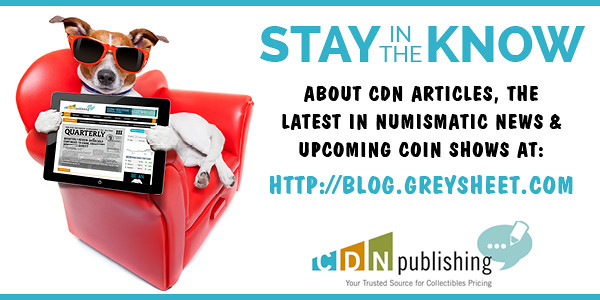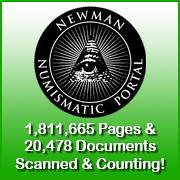
About UsThe Numismatic Bibliomania Society is a non-profit organization devoted to the study and enjoyment of numismatic literature. For more information please see our web site at coinbooks.org SubscriptionsThose wishing to become new E-Sylum subscribers (or wishing to Unsubscribe) can go to the following web page link MembershipThere is a membership application available on the web site Membership Application To join, print the application and return it with your check to the address printed on the application. Print/Digital membership is $40 to addresses in the U.S., and $60 elsewhere. A digital-only membership is available for $25. For those without web access, write to: Terry White, Treasurer AsylumFor Asylum mailing address changes and other membership questions, contact Terry at this email address: terrywhite5475@yahoo.com SubmissionsTo submit items for publication in The E-Sylum, write to the Editor at this address: whomren@gmail.com BUY THE BOOK BEFORE THE COINSale Calendar
|
- WAYNE'S WORDS: THE E-SYLUM MAY 13, 2018
- 2018 NBS BENEFIT AUCTION DONATIONS SOUGHT
- KOLBE-FANNING APRIL 2018 LITERATURE SALE RESULTS
- KOLBE & FANNING EPHEMERA SALE THREE REMINDER
- BOOK REVIEW: CHICAGO COIN CLUB MEDALS AND TOKENS
- NEWMAN PORTAL DIGITIZES THE LETTERED EDGE
- VIDEO: MINT'S WEINMAN ON THE 1933 DOUBLE EAGLE
- NEWMAN PORTAL SEARCH: WOLF ROBE
- SHIPWRECK DISCOVERY CONFIRMED AS THE PULASKI
- ANA MUSEUM ACQUIRES GOODACRE DONATION
- FIRST EDITION WHITMAN COIN FOLDER SET
- NOTES FROM E-SYLUM READERS: MAY 13, 2018
- MORE ON THE FIRST COINS OF THE DENVER MINT
- SAN FRANCISCO MINT GOLD DELIVERY BOOK SOUGHT
- VOCABULARY TERMS: RING TEST, DUMB BLANK
- ABRAHAM ATLAS LEVE (1869-1948)
- HANS SCHULMAN AND THE SCHULMAN FAMILY
- SUBSCRIBER PROFILE: CHRISTOPHER MCDOWELL
- REFLECTIONS ON A COLLECTOR: CHARLES J. RICARD
- AUDIO: COINWEEK PODCAST #97 WITH JOHN KRALJEVICH
- VIDEO: 1964 MORGAN DOLLAR AD
- DECEPTIVELY ALTERED 1792 WASHINGTON CENT
- 1802 HALF DIME QUESTIONED
- LAS VEGAS MAY 2018 COIN SHOW EVENTS
- SEDWICK MAY 2018 AUCTION HIGHLIGHTS
- ARCHIVES INTERNATIONAL SALE 48
- WAYNE'S NUMISMATIC DIARY: MAY 13, 2018
- THE COUNTERSTAMPS OF DR. E. OSGOOD
- MOSCOW ARCHAEOLOGISTS FIND PICKPOCKET COIN
- IRVING BERLIN CONGRESSIONAL MEDAL IMAGE FOUND
- ISRAELI NONPROFIT COINS TRUMP TRIBUTE
- BULGARI'S COIN JEWELLERY
- ROCK CARVING OF WORLD'S EARLIEST BANKNOTE
- AUSTRALIA'S MYSTERIOUS BANKNOTE VAULT
Click here to access the complete archive
To comment or submit articles, reply to whomren@gmail.com
Content presented in The E-Sylum is not necessarily researched or independently fact-checked, and views expressed do not necessarily represent those of the Numismatic Bibliomania Society.
WAYNE'S WORDS: THE E-SYLUM MAY 13, 2018
 New subscribers this week include: Ted Jasik, courtesy of Pablo Hoffman; and Gene Yotka. Welcome aboard! We now have 5,792 subscribers.
New subscribers this week include: Ted Jasik, courtesy of Pablo Hoffman; and Gene Yotka. Welcome aboard! We now have 5,792 subscribers.
Thank you for reading The E-Sylum. If you enjoy it, please send me the email addresses of friends you think may enjoy it as well and I'll send them a subscription. Contact me at whomren@gmail.com anytime regarding your subscription, or questions, comments or suggestions about our content.
This week we open with a note on the 2018 NBS benefit auction, updates from Kolbe & Fanning, a book review, and updates from the Newman Portal including a new video on the 1933 Double Eagles.
Other topics this week include The Lettered Edge, the Pulaski shipwreck, Whitman First Edition coin folders, A. Atlas Leve, Charles Ricard, John Kraljevich, altered and nonexistent coins, pickpocket coins, and coin jewellery.
To learn more about the Chicago Coin Club, the 1933 double eagles, Glenna Goodacre's Sacagawea dollar, the Badian Collection at Rutgers, anguipede figures, Henry Chapman the Neurologist, stolen Republic of Texas banknotes, regulated gold, and Bulgari coin jewellery, read on. Have a great week, everyone!
Wayne Homren
Editor, The E-Sylum
2018 NBS BENEFIT AUCTION DONATIONS SOUGHT
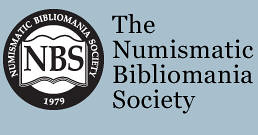 The 2018 General Meeting of the Numismatic Bibliomania Society (NBS) will be held on Friday, August 17 from 11:30 a.m. to 1:00 p.m. at the American Numismatic Association's World's Fair of Money in
Philadelphia, Pennsylvania. The meeting will conclude as usual with a benefit auction of numismatic books and related items donated to be sold for the benefit of the organization.
The 2018 General Meeting of the Numismatic Bibliomania Society (NBS) will be held on Friday, August 17 from 11:30 a.m. to 1:00 p.m. at the American Numismatic Association's World's Fair of Money in
Philadelphia, Pennsylvania. The meeting will conclude as usual with a benefit auction of numismatic books and related items donated to be sold for the benefit of the organization.
Donations have already been received from several NBS supporters, but more are needed to make the auction a success. NBS Board member David Fanning has volunteered to catalogue and conduct this year's sale. Donated items may be sent to him at:
Kolbe & Fanning Numismatic Booksellers
141 W Johnstown Road
Gahanna OH 43230
He can be reached at df@numislit.com if you have any questions. All proceeds from the auction go to the Numismatic Bibliomania Society, with any expenses incurred in conducting the sale being donated to the NBS. Thank you for your consideration. Donations must be received by July 15.
Eric P. Newman's presentation copy of The Moxie Encyclopedia, inscribed to him by the author (donated by the Eric P. Newman Numismatic Education Society).
To read the earlier E-Sylum article, see:
NBS BENEFIT AUCTION AT 2018 ANA CONVENTION (http://www.coinbooks.org/v21/esylum_v21n09a04.html)
THE BOOK BAZARRE
KOLBE-FANNING APRIL 2018 LITERATURE SALE RESULTS
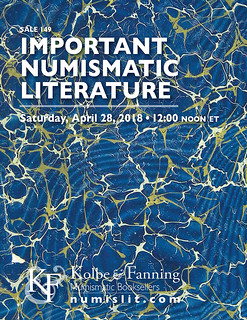 The market for numismatic literature is alive and well, as Kolbe & Fanning's mail-bid and live online auction on April 28 realized over $110,000.
The market for numismatic literature is alive and well, as Kolbe & Fanning's mail-bid and live online auction on April 28 realized over $110,000.
As co-owner David Fanning said, “This was the most successful mail-bid sale we’ve had in the past few years. We had a very strong 184 registered bidders for a 500-lot sale.”
He said that although the market for numismatic books has been a bit slow over the past several years as collectors adjust to the many works available online, buyers are coming back and starting to add to their collections once again. Fanning explained, “As people became more used to these online resources, most of them began to feel that there was a need for both printed matter and online content. Most people aren’t going to read an entire book on their screens.”
Fanning also said that researchers and hobbyists alike are recognizing the appeal of physical books. “It can be easier to use multiple books or catalogues when writing a coin description, for instance, than it can be to toggle back and forth between multiple screens using various programs or formats,” Fanning said, advising potential collectors looking to add to their libraries, “there is tremendous value in good numismatic books.”
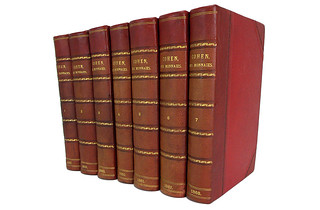
Lot 43
Lot 43: a lovely set of the first edition (1859-68) of Cohen on Roman Imperial coins, bound in matching red half morocco; brought $1,000
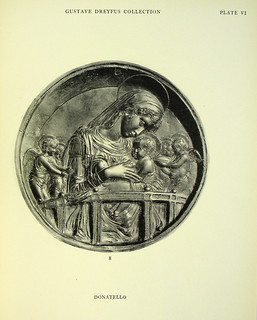

Lots 183 and 21
Lot 183: De Ricci's massive catalogue of the Gustave Dreyfus collection of Renaissance reliefs and plaquettes; sold for $3,250 hammer.
Lot 21: Edward T. Newell's copy of a plate volume of Babelon's Traité des monnaies grecques et romaines; sold for $2,000 hammer.
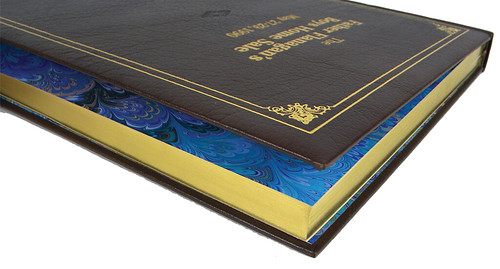
Lot 475
Lot 475: the only copy we have handled of the ultra-deluxe Superior catalogue of the Boys Town collection, bound in full water buffalo skin with a matching clamshell case; brought $900
To read the complete article, see:
Kolbe & Fanning sale presents solid values in numismatic literature
(https://www.coinworld.com/news/us-coins/2018/05/Kolbe-Fanning-sale-presents-solid-values-in-numismatic-literature.html)
To read the earlier E-Sylum articles, see:
KOLBE & FANNING SALE 149 CLOSES APRIL 28, 2018 (http://www.coinbooks.org/v21/esylum_v21n14a02.html)
MORE KOLBE & FANNING SALE 149 HIGHLIGHTS (http://www.coinbooks.org/v21/esylum_v21n15a02.html)
KOLBE & FANNING EPHEMERA SALE THREE REMINDER
KOLBE & FANNING EPHEMERA SALE CLOSES FRIDAY, MAY 18
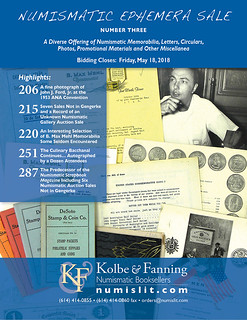 Kolbe & Fanning Numismatic Booksellers are conducting our third Numismatic Ephemera Sale, which closes on Friday, May 18, 2018. The sale includes 100 lots of numismatic memorabilia, short sale catalogues,
photographs, letters, brochures, leaflets, booklets, and so on.
Kolbe & Fanning Numismatic Booksellers are conducting our third Numismatic Ephemera Sale, which closes on Friday, May 18, 2018. The sale includes 100 lots of numismatic memorabilia, short sale catalogues,
photographs, letters, brochures, leaflets, booklets, and so on.
A few highlights include:
• Lot 203: a scarce early G. Frederick Kolbe numismatic literature list from 1974.
• Lot 212: an unlisted Central States Numismatic Society auction for May 12, 1951 conducted by Paul B. Slosson.
• Lot 218: a variety of short lists and catalogues issued by Leonard Forrer.
• Lots 237 and 238: correspondence relating to John J. Pittman's application for membership in the American Numismatic Association.
• Lot 248: an interesting 1944 letter from T. James Clarke to Leonard Holland.
• Lot 255: a finely engraved portrait of British numismatist John Pinkerton.
The catalogue is in PDF form only: there is no printed catalogue, nor is there online bidding. This is purely an old-fashioned mail-bid sale. The catalogue may be downloaded from Kolbe & Fanning's website at numislit.com. Please read the Terms of Sale. We thank you in advance for your participation!

BOOK REVIEW: CHICAGO COIN CLUB MEDALS AND TOKENS
Author William A. Burd Signature Book Printing 2018
Reviewed by John and Nancy Wilson
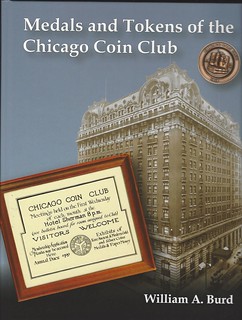 Medals and Tokens of the Chicago Coin Club by William A. Burd is a recently released hard-bound reference with 108 pages and over 150 photographs. All items are in color and actual size. We agree with Carl Wolf,
that this reference will set the standard for the hundreds of collectibles which were issued for the club.
Medals and Tokens of the Chicago Coin Club by William A. Burd is a recently released hard-bound reference with 108 pages and over 150 photographs. All items are in color and actual size. We agree with Carl Wolf,
that this reference will set the standard for the hundreds of collectibles which were issued for the club.
The author joined the club in 1993 and his first purchase was the club's 75th Anniversary medal. From that beginning Bill has assembled probably the finest collection of CCC medals and tokens possible. The book starts with the Chicago Numismatic Society's first meeting in January 1904 and first token issued in 1907. He continues with all items issued by the Society covering the history, mintage, metal content, etc. This theme continues throughout the book.
The Second Chapter explains the ANA's Branch clubs, especially Chicago's Branch #1, formed after the ANA received a Federal Charter in 1912.
Chapter 3 deals with Chicago Coin Club medals and tokens and associated ephemera issued from the club's start in 1919 to the present day. They commemorate annual events as well as milestone anniversaries such as 25th, 50th, 75th through the 95th in 2014. Most medals were issued in both copper and silver and 6 different issues were also available in gold. These include two reduced replicas of sculptures by James Earl Fraser and a medal depicting Augustus Saint-Gaudens’ “Standing Lincoln” statue.
Chapter 4 deals with the sixteen ANA Conventions held in Chicago. Described are the many different medals, tokens, badges, speaker's medals, and souvenirs issued by the Chicago Coin Club to commemorate the conventions.
Chapter 5 covers the Central States Numismatic Society conventions held in Chicago and hosted by the club. In 1939 the Chicago Coin Club hosted a two-day event called the Central States Numismatic Conference at which time the Society was formed. Over the years the club hosted 5 additional events and issued various items for each.
There are four appendices which cover club awards; souvenir sheets; publications; and the Chicago Numismatic Roundtable.
We recommend this book to anyone who collects numismatic club material. It is also a good read for any officer of a numismatic club for an insight into the workings of a dynamic organization that has been active for 100 years. The reference can be purchased for $30.00, which includes postage and handling. Checks should be made out to the Chicago Coin Company and sent to them at: Chicago Coin Co., Inc., 6455 W. Archer Avenue, Chicago, IL., 60638.
To read the earlier E-Sylum article, see:
NEW BOOK: CHICAGO COIN CLUB MEDALS AND TOKENS (http://www.coinbooks.org/v21/esylum_v21n10a04.html)
NEWMAN PORTAL DIGITIZES THE LETTERED EDGE
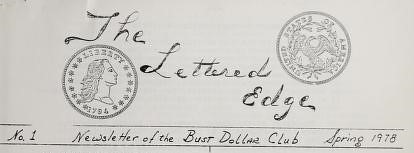
The number of U.S. periodical titles related to numismatics likely numbers over a thousand. Remy Bourne has made the best attempt to catalog these, in his two-volume set American Numismatic Periodicals, 1860-1960. One of the more ephemeral titles is The Lettered Edge, a four-issue series spanning 1978-1980. Produced by Jules Reiver and Bob Stark on behalf of the Bust Dollar Club, this periodical aimed to boost interest in varieties of early silver dollars (1794-1803).
Reiver held the most comprehensive set of 18th and 19th century American die varieties (ultimately cataloged by Heritage Auctions in a January, 2006 3-volume set) and was naturally involved in the effort. The set is readable, containing tidbits of inside dope, but ultimately building a large coterie of early dollar collectors by Bolender (or Borckardt-Bowers) varieties is a Herculean challenge, as a typical example is well into four figures. Nevertheless, most anything related to Reiver's numismatic activity is worth preserving, and, with the assistance of W. David Perkins, The Lettered Edge is now available on Newman Portal.
Link to The Lettered Edge on Newman Portal:
https://nnp.wustl.edu/library/publisherdetail/525963
Link to American Numismatic Periodicals on Newman Portal:
https://nnp.wustl.edu/library/books
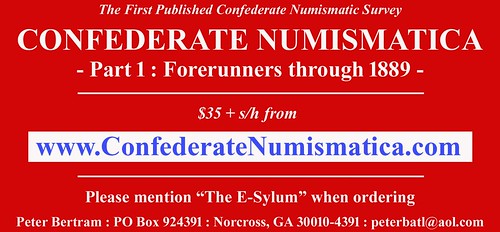
VIDEO: MINT'S WEINMAN ON THE 1933 DOUBLE EAGLE
Greg Weinman, U.S. Mint Senior Counsel, Speaks on 1933 Double Eagle

This week at the PAN (Pennsylvania Association of Numismatists) convention Greg Weinman, U.S. Mint Senior Counsel, spoke on the 1933 double eagle and the extensive litigation surrounding this controversial coin. The 1933 double eagle has inspired spirited (and endless) debate within the numismatic community, but heretofore the Mint has not freely commented on the legal proceedings. Weinman summarizes the long record of litigation and presents the Mint's point of view on the subject. Weinman also announced a related exhibit at the U.S. Mint in Philadelphia, to be opened coincident with the ANA World's Fair of Money in August. Coin Television, operated by David Lisot, videotaped Weinman's presentation under sponsorship of the Newman Portal. Thanks to Tom Uram, PAN president, for facilitating this recording.
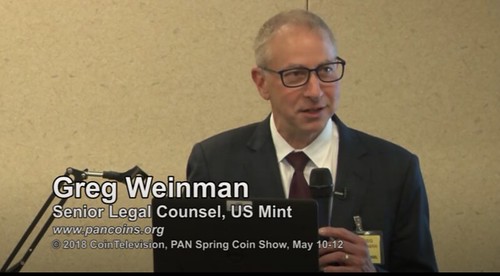
Link to Greg Weinman video on Newman Portal:
https://nnp.wustl.edu/library/book/545751

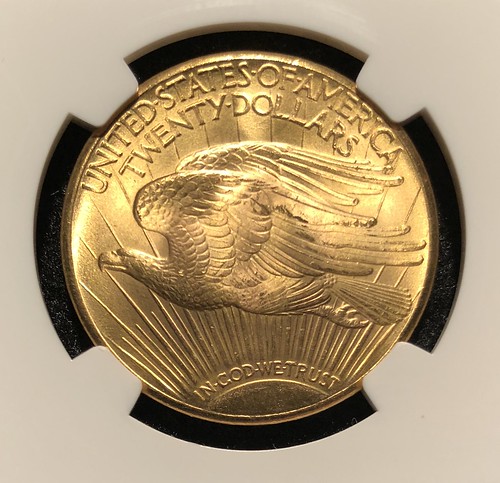

David Lisot filming the presentation
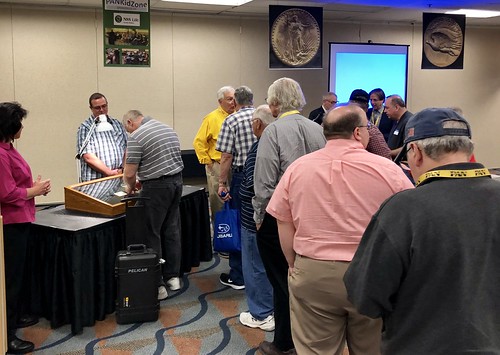
Crowd waiting to view the coin
NEWMAN PORTAL SEARCH: WOLF ROBE

A Newman Portal user searched this week for “wolf robe,” which we took to be a typographical error for “Wolfeboro,” the location of the Stack's Bowers New Hampshire office. Not the case! Wolf Robe was a 19th century Cheyenne leader who was presented with a Benjamin Harrison peace medal (Julian IP-48), c. 1890.
Fake Indian peace medals seemingly outnumber the genuine article by several orders of magnitude, but in this case there is contemporary photographic evidence of Wolf Robe wearing such a medal. Francis Paul Prucha's Indian Peace Medals in American History identifies 18 recipients of this medal, including Wolf Robe. An example of the Harrison medal, engraved by Charles Barber, was presented for sale by Stack's Bowers in February 2015, where it sold for $49,937.50.
Image: Benjamin Harrison Indian Peace medal engraved “Three Fingers,” from Stack's Bowers 2/2015, lot 41.
Link to Stack's Bowers February 2015 sale, lot 41, on Newman Portal
https://nnp.wustl.edu/library/auctionlots?AucCoId=3&AuctionId=517104&page=26

SHIPWRECK DISCOVERY CONFIRMED AS THE PULASKI
Divers have found proof that a shipwreck off the North Carolina coast is a steam ship that sank in 1838.
A tiny tag and a candlestick holder recovered from the wreck site bear the name of the ship 'S.B Pulaski' - for Steam Boat Pulaski - on its bottom, recovery firm Blue Water Ventures International have confirmed.
'This is a game changer. I have believed for so long we were in the right spot, and there's nothing like the feeling of having something like this confirmed,' the company's Keith Webb said.
Dr. Joseph Schwarzer, director of the North Carolina Maritime Museums, was among the historians waiting for Webb to prove he was in the right spot.
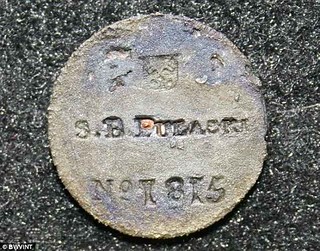

S.B Pulaski metal tag and candlestick
Schwarzer was hoping for the ship's bell, but he says a candlestick holder with the ship's name is just as good.
'That really is a smoking gun,' Schwarzer said. 'It's like finding proof of something which was not just history, but almost legendary.
'This is empirical evidence. The wreck is no longer folklore, on the pages of a book.
'There is an actually object that proves it is out there.'
Blue Water Ventures International and Endurance Exploration have been working to recover coins and other valuables from a wreckage site.
The coins that have been found by the operation's divers so far are dated to no later than 1836.
They include early United States silver issues and Spanish silver coins from the late 1700s.
But the facts that the coinage found on the boat predates 1838 and that analysis of the wreckage corroborates a boiler explosion were seen as promising by the exploration team.
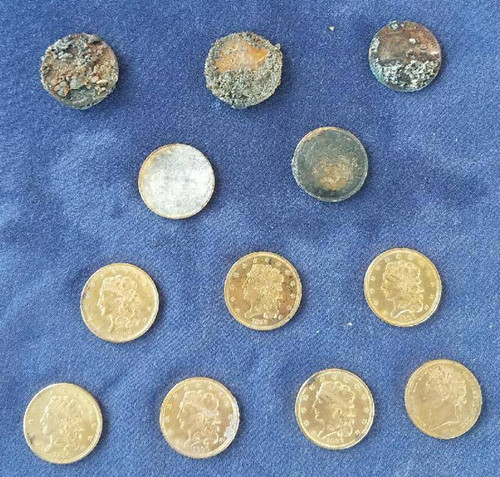
To read the complete article, see:
Divers confirm wreck off North Carolina coast is famed steamship Pulaski
that exploded and sank 180 YEARS ago killing dozens of the Southern elite (http://www.dailymail.co.uk/news/article-5718545/Divers-confirm-wreck-North-Carolina-coast-famed-steamship-Pulaski-sank-180-years-ago.html)
To read the earlier E-Sylum articles, see:
NCS and NGC Selected to Conserve and Grade SS Pulaski Coins (https://www.ngccoin.com/news/article/6524/SS-Pulaski/)
Gold coins recovered from wreck (http://www.numismaticnews.net/article/gold-coins-recovered-wreck)
NCS TO CONSERVE SS PULASKI COINS (http://www.coinbooks.org/v21/esylum_v21n13a25.html)
ANA MUSEUM ACQUIRES GOODACRE DONATION
The Edward C. Rochette Money Museum received an exciting donation in late 2017: items related to the production of the Sacagawea dollar from the studio of acclaimed sculptor Glenna Goodacre. The donation is a great addition to the ANA's collection of plasters, galvanos and other production-related objects associated with famous numismatic engravers and sculptors such as Gilroy Roberts, John Sinnock and Adam Pietz.
 The story of the Sacagawea dollar began in 1997, when the U.S. Treasury realized the stock of Susan B. Anthony dollars (last struck in 1981) was critically low, and because these dollars were often mistaken for
quarters. The subsequent United States Dollar Coin Act of 1997 required a new circulating gold-colored dollar coin similar in size to the Susan B. Anthony dollar. Secretary of the Treasury Robert E. Rubin created the Dollar
Coin Design Advisory Committee responsible for coming up with a design with the following characteristics: it must not depict a living person, it must depict one or more women, and it must maintain a dignity befitting the
nation's coinage.
The story of the Sacagawea dollar began in 1997, when the U.S. Treasury realized the stock of Susan B. Anthony dollars (last struck in 1981) was critically low, and because these dollars were often mistaken for
quarters. The subsequent United States Dollar Coin Act of 1997 required a new circulating gold-colored dollar coin similar in size to the Susan B. Anthony dollar. Secretary of the Treasury Robert E. Rubin created the Dollar
Coin Design Advisory Committee responsible for coming up with a design with the following characteristics: it must not depict a living person, it must depict one or more women, and it must maintain a dignity befitting the
nation's coinage.
In July 1998 the committee recommended that Sacagawea, the Shoshone woman who played a crucial role in the success of the Lewis and Clark expedition, should appear on the new coin. The Mint requested design submissions and in May 1999 the United States Commission on Fine Arts selected the final designs: the obverse by Glenna Goodacre and the reverse by Thomas D. Rogers, Sr. The coins were officially released for circulation in 2000 and were produced until 2008. Goodacre's Sacagawea design is still used today for the obverse of the ongoing Native American dollar series.
In addition to her Sacagawea design, Glenna Goodacre (1939-present) is known for her bronze sculptures – the most famous being the Vietnam Women's Memorial in Washington, D.C. (pictured). The Texas native graduated from Colorado College and established a studio in Santa Fe, NM, where she spent most of her professional life. She retired in 2016 after a 50-year career and donated her tools, clay and equipment to the New Mexico School for the Arts. In 2008 her hometown of Lubbock, TX dedicated Glenna Goodacre Boulevard near Texas Tech University.
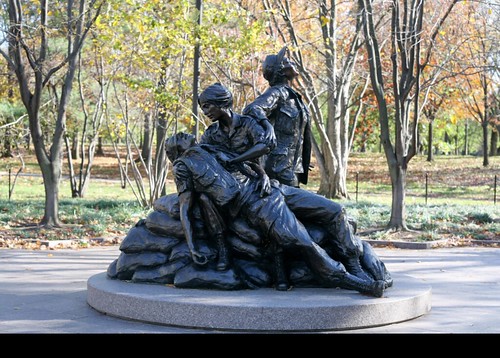
The ANA's Sacagawea collection was donated by Daniel Anthony, Goodacre's business manager for many years, after a conversation with former ANA President Jeff Garrett. The donation includes one of three plaster-casts of the original design submitted by Goodacre, along with a plaster of the final design, a test piece in bronze to study the design with a polished finish, and examples of the first coins struck by the Mint.
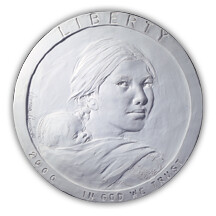
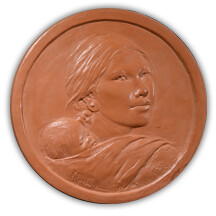
Other interesting pieces in the donation include:
• “The Offering” – a beautiful small bronze statue showing Sacagawea looking up to the heavens while holding her dollar up and out in front of her.
• A plaster showing an alternate version of the Sacagawea design, requested by Secretary of the Treasury Rubin, without Sacagawea's baby Jeanne Baptiste on her back. Produced in 1998, it was much less popular than the design with the child.
• A terra cotta rendition, used as a test piece to study the relief of the design.
• A large (7 ¾”) cast bronze of the final design.
To read the complete article, see:
Tales From the Vault - The Sacagawea Dollar (https://www.money.org/blog/sacagawea)

FIRST EDITION WHITMAN COIN FOLDER SET
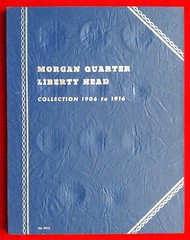
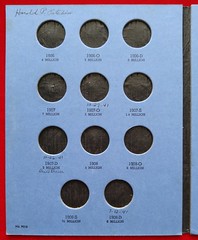
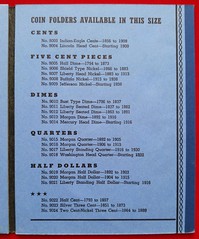
I achieved something this week that would likely go unnoticed by most in the hobby, but it was memorable for me. I added two missing titles to my collection of First Edition Whitman coin folders, leaving me with just two remaining to complete it. The newly acquired folders were No. 9022, HALF CENT COLLECTION 1793 to 1857 and No. 9020, MORGAN HALF DOLLAR LIBERTY HEAD COLLECTION 1904 to 1915. To date, these are the only examples I've ever seen.
As indicated on the end flap of the folder in the attached photos, there were a total of 22 titles in Whitman's First Edition of coin folders. All but five of these had been part of the Whitman line of 11" x 14" coin boards, and most titles were discontinued in board form when the folders debuted in 1941.
The First Edition folders are identifiable by their deeply textured cover paper, which a fellow collector describes as "lizard skin." Unlike later folders, this paper was somewhat glossy when new, and it's extremely rare to find examples that retain this shine. The onset of World War II brought with it rationing of most materials, including paper. Whitman was forced to shift to a cheaper cover stock that was plainer in pattern and matte in finish. The First Edition folders were in production only during 1941 and the opening months of 1942, accounting for their great rarity.
At present the only titles still lacking in my collection of First Edition folders are No. 9023, SILVER THREE CENT COLLECTION 1851 to 1873 and No. 9019, MORGAN HALF DOLLAR LIBERTY HEAD COLLECTION 1892 to 1903. The first of these may never be found, since it was a poor seller in any edition, though I entertain hope of finding the half dollar title.
The folder in the photos was annotated by its original owner, who wrote what I assume to be the date of acquisition and source for several of his coins. While some would consider this folder to be defaced, I'm pleased to have this personalized piece of coin hobby history.
To read earlier E-Sylum articles, see:
LANGE'S COIN COLLECTOR BOARD BOOK ARRIVES (http://www.coinbooks.org/esylum_v10n38a07.html)
NEW BOOK: COIN COLLECTING ALBUMS, VOLUME ONE (http://www.coinbooks.org/esylum_v16n32a02.html)
BOOK REVIEW: COIN COLLECTING ALBUMS, VOLUME TWO (http://www.coinbooks.org/esylum_v19n31a12.html)
To visit Dave's web site, see:
http://www.coincollectingboards.com/
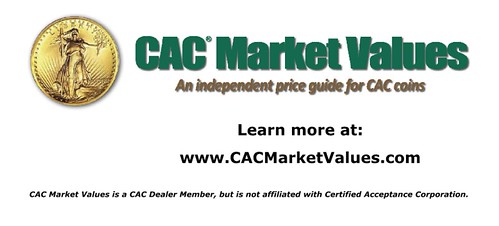
NOTES FROM E-SYLUM READERS: MAY 13, 2018
Searching the Badian Collection at Rutgers
Ed Hohertz writes:
This may have been covered before, but the Badian Collection at Rutgers is now on-line. Under Search the Collection I was impressed with the contents of the Browse tab and its detailed index of items on the coins. One can pull up all of the coins in the collection with a gate or Jupiter Anxurus or an anguipede figure etc.
If you're like me, you're wondering what an "anguipede figure" is. Well, I did the search and found three. Here's the description of the reverse of a Roman denarius c. 118 B.C.E.-107 B.C.E. -Editor
Jupiter in quadriga to right, holding scepter and reins in left hand and hurling thunderbolt with right hand; on either side, star; above, head of Sol and crescent; below, anguipede giant with thunderbolt in right hand and with left hand raised; in exergue, •L•F (NE ligatured); border of dots
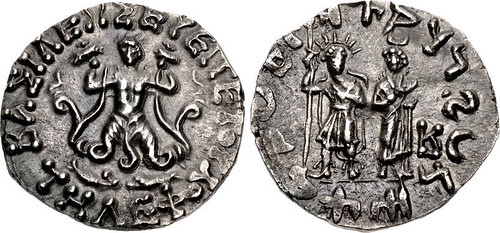
Coin of Indo-Greek king Telephos displaying an anguipede with limbs ending in lotus blossom (obverse).
To read the Wikipedia article, see:
Anguiped (https://en.wikipedia.org/wiki/Anguiped)
To view the collection, see:
http://coins.libraries.rutgers.edu/romancoins/
To read the earlier E-Sylum article, see:
RUTGERS DIGITIZES ROMAN COIN COLLECTION (http://www.coinbooks.org/v21/esylum_v21n11a17.html)
Palau Crocodile Carving Shows Yap Stones
E-Sylum reader Etienne Le Pen writes:
As a dealer and ardent traveler, I'd often stop in the Pacific Islands to learn about and acquire new treasures.
It seems that 'regret' is a part of every numismatist's portfolio, and I'm no exception. Gee, if I didn't sell all those Stephen Fuller Austin documents as a kid, or that hoard of California gold or the hundreds of St. John's River notes etc, are thoughts that always run through my mind.
Although all the Yap pieces are in museums today, I have held on to a nice reminder of those great stones; this carving made in the prison on Koror, Palau depict these 'Money' stones, all within a native salt water crocodile format (measures 5'). Native wood is almost as good as stone, and it's not like carrying away their national treasure.

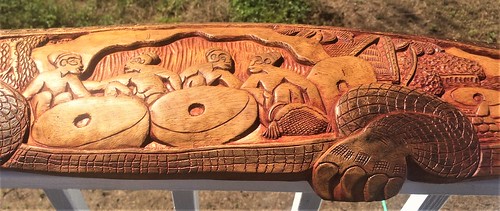
To read the earlier E-Sylum article, see:
TRAVEL ARTICLE HIGHLIGHTS YAP STONE MONEY (http://www.coinbooks.org/v21/esylum_v21n18a24.html)
More King Menelik II Memorabilia
In response to an illustration in last week's Numismagram article, Etienne Le Pen adds:
Regarding the Menelik II Railroad Commemoration Medal - Check out this outstanding share (engraved by the famous military illustrator Louis Charles Bombled, 1862-1927) featuring none other than King Menelik II and his entourage awaiting an oncoming locomotive. Question (rhetorical)...Is that a Khat plant (the National Chew) in the foreground?
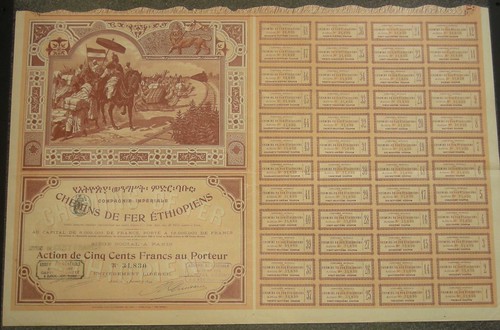
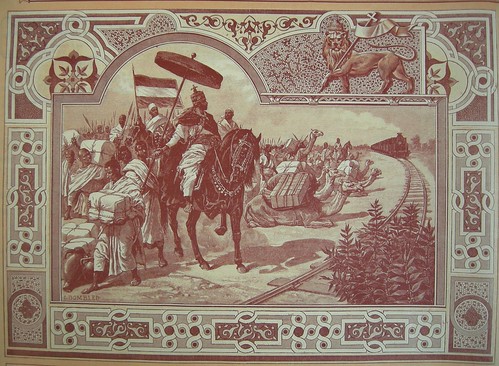
To read the earlier E-Sylum article, see:
MEDALS FROM NUMISMAGRAM: PLANES AND TRAINS : ETHIOPIA. Ethio-Djibouti Railway Medal (http://www.coinbooks.org/v21/esylum_v21n18a28.html)
Henry Chapman, Neurologist
John Lupia writes:
I found this while going through my Chapman Archive and thought you and E-Sylum readers would find this amusing.
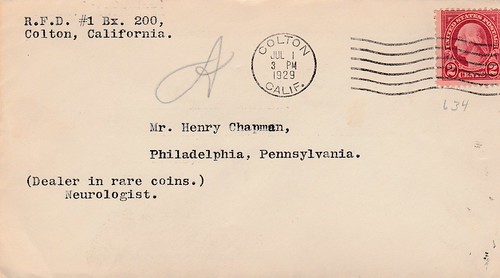
John adds:
Well, the word started with an "N" and ended in "ist".
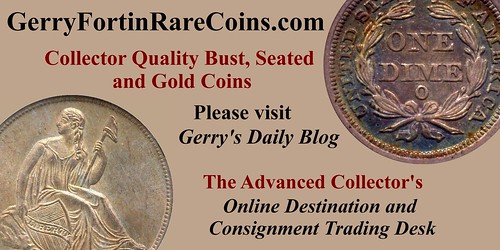
MORE ON THE FIRST COINS OF THE DENVER MINT
Dave Lange writes:
I was intrigued by the article about the first coinage of the Denver Mint. I was under the impression that the sequence of striking was already known, and it formed the basis of one of my columns in The Numismatist, which was later reprinted in NGC News.
This month's theme is provided by a brief sidebar article that ran in the July-August 1999 issue of Rare Coin Review, the house organ of what was then Bowers and Merena Galleries. It relates the dates on which coinage commenced at the Denver Mint for each denomination from 1906-13. The editor of RCR did not know the provenance of this information, as it was simply found amidst a pile of other documents and letters, but it provides us now with some interesting trivia.
The Denver Mint was established April 26, 1862 when Congress approved the purchase of Clark, Gruber and Company of that city. This firm had coined gold pieces with its own stamp in 1860-61 and thus possessed the necessary facility and equipment. Denver, however, became a United States mint in name only, as it operated solely as a federal assay office for the next 40+ years. It was not until 1906 that the Denver Mint finally struck USA coins in a large structure built for that purpose two years earlier.
Coining actually commenced October 28, 1905 with a commemorative token marking the mint's official opening. This piece was produced in both bronze and silver and measures 35mm, about the size of a double eagle. One side is plain, and the other states simply DENVER / 1905. The edge of these tokens is reeded. Bronze examples are fairly scarce, and the silver striking is genuinely rare.
The honor of being the first actual coin struck at the Denver Mint goes to the quarter dollar, production of which commenced February 15, 1906. Some 3,280,000 pieces would be coined by year's end, making this issue one that collectors easily can acquire in any grade shy of gem Mint State. The minting of dimes began almost two weeks later on February 27. This is another common, inexpensive issue, as more than four million were produced at Denver in 1906. The first half dollar fell from the coin press on March 2, and its yearly total was similar to that of the dime. All three of these coins bear Charles Barber's classical bust of Liberty, and they would make a nice souvenir set that any collector can afford to build.
To read the complete article, see:
USA Coin Album: Scrapbook Gold - Part 4 (https://www.ngccoin.com/news/article/4749/USA-Coin-Album/)
David Stone writes:
The article in the Aspen Democrat on the first coinage of the Denver Mint was very interesting. For more info on early D-mint coinage, check out pages 68-69 of the 1914 ANS Exhibition catalog (see attached). Denver collector Edward B. Morgan faithfully collected all coinage issues from the Denver Mint and recorded their dates of issue.
I suspect Morgan's dates are when the coins first became available to the public, not the day they were actually manufactured. He gives March 2, 1906 as the first coinage of half dollars from the Denver Mint, a month later than the newspaper article, which seems to describe the actual production date. Morgan's notes indicate the quarters were released first, on February 15. He also notes a commemorative copper issue was struck on October 28, 1905 to celebrate the opening.
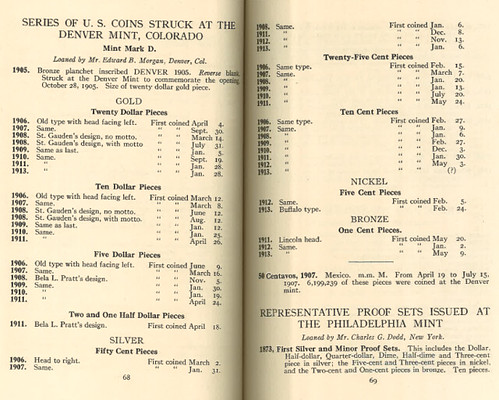
To read the earlier E-Sylum article, see:
THE FIRST COINS OF THE DENVER MINT (http://www.coinbooks.org/v21/esylum_v21n18a15.html)
SAN FRANCISCO MINT GOLD DELIVERY BOOK SOUGHT
William A. ("Bill") Shirley writes:
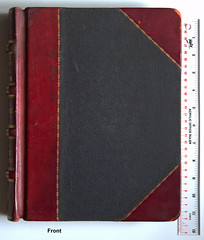 I thought your group might be interested to know that I just posted eBay item # 290548470584 which is a "Gold Delivery Book - Coiner" containing original handwritten records from
the San Francisco Mint during the July 1906 to June 1911 time period. Obviously, I'm trying to get a free plug in The E-Sylum. My auction is running to March 29, 2011.
I thought your group might be interested to know that I just posted eBay item # 290548470584 which is a "Gold Delivery Book - Coiner" containing original handwritten records from
the San Francisco Mint during the July 1906 to June 1911 time period. Obviously, I'm trying to get a free plug in The E-Sylum. My auction is running to March 29, 2011.
 This is an original record book from the United States Mint in San Francisco ( the San Francisco Mint ). This book was thrown out or sold after the Mint closed years ago, along with the
minting equipment and other items. The book is bound in leather and cloth. It is marked, in gold lettering, on the spine " Gold Delivery Book - Coiner - Form No. 865 - U.S. Mint San Francisco - U.S. Government Bindery
."
This is an original record book from the United States Mint in San Francisco ( the San Francisco Mint ). This book was thrown out or sold after the Mint closed years ago, along with the
minting equipment and other items. The book is bound in leather and cloth. It is marked, in gold lettering, on the spine " Gold Delivery Book - Coiner - Form No. 865 - U.S. Mint San Francisco - U.S. Government Bindery
."
The pages are designed to be able to be filled in with the number of the delivery, the number of drafts, the amount in dollars, the actual weight, the legal weight, the variation, and denomination of all coin deliveries made to the superintendent.
The records in this book begin with July 26, 1906, and continue until June 22, 1911, on 45 pages (22 two-sided pages plus 1 one-sided page). Some pages appear to have been torn from the book, i.e., the records between October 18, 1906, and August 13, 1907, are missing and page remnants remain. In addition, a two-sided page with data for September 17. 1910, to October 19, 1910, appears to be missing. Records for the Coiner's Delivery of Gold on September 20, 1907, and October 6, 1907, are contained on two facing pages, well bound, but separated from the main 45 pages by approximately 41 (double-sided) pages after the bulk of the records. The information seems to be presented by date of the month and details the number of half eagles, eagles, and double eagles delivered. The type of coin delivered (e.g., double eagle) is stamped with a rubber stamp.
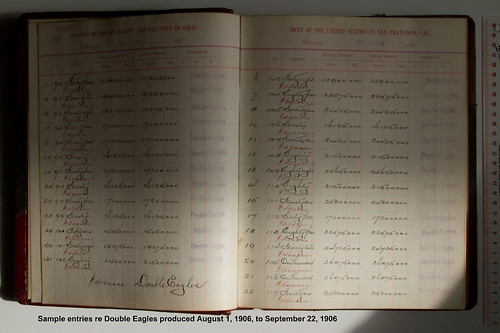
To visit the eBay auction, see: U.S. MINT SAN FRANCISCO GOLD DELIVERY BOOK - COINER
To read the original article, see:
SAN FRANCISCO MINT GOLD DELIVERY BOOK OFFERED (http://www.coinbooks.org/esylum_v14n13a09.html)
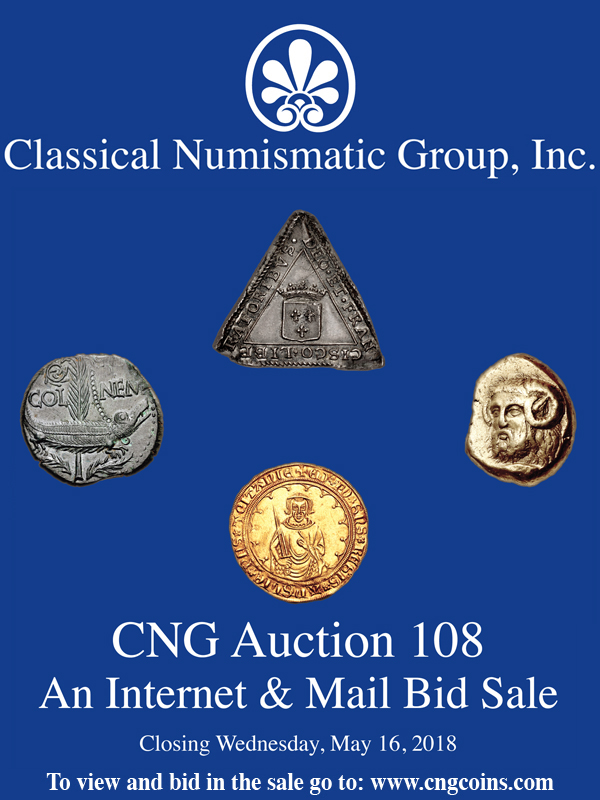
VOCABULARY TERMS: RING TEST, DUMB BLANK
Ring Test. Tapping a suspended coin or medal on the edge for its resonance. The ring of any small metal object is due to its internal structure; thus its alloy, thickness and any gas pockets affects its tone. Both cast and struck items will ring but with notes of different pitch. It is necessary to compare a suspect item with a known or genuine item. Using a ring test for authentication, however, is delusive.
A ring test could detect a cast copy, for example, but could not differentiate a struck copy from an original. It could detect different metal compositions but not minute differences of alloy. The sounds of the ring test could range from a high prolonged tone (from a large thin piece) to a dull thud (from a thick base metal cast). A DUMB BLANK would fail a ring test by such a dull thud, as well as coins with a LAMINATION ERROR will fail the ring test.
A ring test is critical for gold coins. Concerned mints have employed testers to bounce freshly struck gold coins on a metal drum to check if they ring true. Dumb blank coins would be rejected and melted. The Philadelphia
Mint did this, for example, until the early 1930s.
CLASS 11.2
Dumb Blank. A planchet which fails a ring test (because of trapped gas, cracks or other imperfections in the metal). A piece struck from a dumb blank would still fail a similar RING TEST.
Testing for dumb blanks is critical for gold coins; Breen states J.S. Ormsby $5 and $10 gold pieces were struck on dumb blanks because of poor refining.
CLASS 06.9
Reference:
NC10 {1988} Breen, p 634-635.
Looking for the meaning of a numismatic word, or the description of a term? Try the Newman Numismatic Portal's Numismatic Dictionary at: https://nnp.wustl.edu/library/dictionary
ABRAHAM ATLAS LEVE (1869-1948)
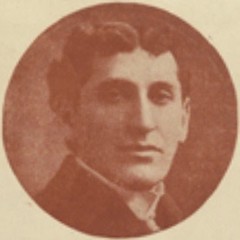 A. Atlas Leve, as he was popularly known was a coin, stamp, and curios dealer. His specialty was rare paper money including Confederate, Broken Bank Bills, Colonial and Continental Notes, Foreign Notes, and also,
autographs, portraits, and Lincoln medals.
A. Atlas Leve, as he was popularly known was a coin, stamp, and curios dealer. His specialty was rare paper money including Confederate, Broken Bank Bills, Colonial and Continental Notes, Foreign Notes, and also,
autographs, portraits, and Lincoln medals.
He was a regular client and correspondent with the Chapman Brothers. There are many letters in the archive and will post one or two as time allows.
In 1902 he was the publisher of The New Perforator, a philatelic monthly.
He published an article on the new cent design titled "The Lincoln Cent" published on August 19, 1909, New York Times, page 6.
 In late November 1915, A. Atlas Leve became entangled in a feud with B. Max Mehl regarding stolen Republic of Texas Bank Notes, found in a Mehl auction sale lot. In the press Leve called Mehl by the pseudonym Mox
Nix Nil. The feud lasted two years in the press.
In late November 1915, A. Atlas Leve became entangled in a feud with B. Max Mehl regarding stolen Republic of Texas Bank Notes, found in a Mehl auction sale lot. In the press Leve called Mehl by the pseudonym Mox
Nix Nil. The feud lasted two years in the press.
He read a paper at the ANA annual convention in Baltimore, September 23, 1916, titled : "Some Paper Money I Have Met", which was published in the December 1916 issue of The Numismatist, pages 549-551. In that essay he discussed the 20,000 Texas bank notes, warrants and bonds signed by Sam Houston. Leve was instrumental in having these notes restored to the Texas Historical Society.
In 1918, he was the publisher of The American Collector.
He published his poem "Collector's Lament" in the November 1919 issue of The Numismatist, page 455.
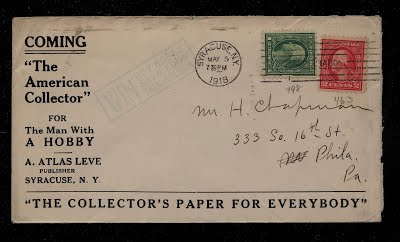
He died on August 2, 1948 at Syracuse, Onondaga County, New York. He is buried at Westchester Hills Cemetery, Westchester County, New York.
To read the complete article, see:
LEVE, ABRAHAM ATLAS (https://sites.google.com/a/numismaticmall.com/www/numismaticmall-com/leve-abraham-atlas)
The entire inventory of the Lupia Numismatic Library is for sale. Individual items will be available before the remaining archives are broken up into parcels sold at philatelic auctions in the U. S. and Hong Kong. Check NumismaticMall.com frequently as dozens of new items with estimates will be posted daily until everything is sold.
All inquiries will be given prompt and courteous attention. Write to: john@numismaticmall.com .
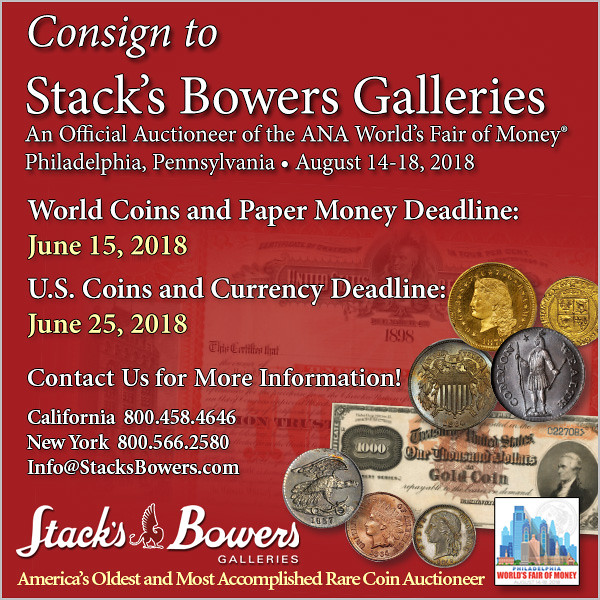
HANS SCHULMAN AND THE SCHULMAN FAMILY
Dave Hirt of Frederick, MD writes:
I saw you asked for memories of Hans Schulman. I attended one of his sales at the Waldorf Hotel in 1958 or 1959. It was a sale conducted together Abner Kreisberg. Before the sale started Kreisberg was joking around with Schulman, but the serious Hans didn't seem to think it was funny.
After that sale Schulman kept me on his mailing list for auction catalogs and fixed price lists for many years, even though I seldom bid, as he mostly cataloged world coinage, which I usually did not collect. However, his well-plated catalogs were always interesting to read. I still have them in my library today. Schulman never sent out PRLs after the sale. If you wanted one you had to pay for it. I believe today that his sales with prices are much scarcer than unpriced ones.
Schulman held two sales of numismatic literature, one in 1966 and one in 1968. I was a successful bidder in both of these.
Jeffrey S. Zarit writes:
Where do I start ?
In the mid 1970's I was traveling to Europe a couple of times a year, to try and buy coins. I remember one colleague who told me about Jacques Schulman at Keizersgracht 448, in Amsterdam, The Netherlands. so I went by train, and took a taxi to his address.
When I walked in, I remember Jacques sitting at a long desk, with a lady sitting opposite him. There was an odor in the air, but as I was a smoker then, it did not bother me. I walked up to Jacques and introduced myself and told him that i was interested in Dutch and world coins. He was very gracious and pointed to the safes around the room, all filled with trays of coins; and he told me to pick out what I was interested in. I did so, and he treated me like a colleague and thus started a long term relationship with the Schulman's of Amsterdam.
Fast forward a couple of years and I made it a point to visit Jacques whenever I was in the area. I remember looking at an obscure coin in one of the trays, and I went home without it. I did the research at home and about six months later when again I was in Amsterdam, the coin had not been sold and I bought it. Always gracious, the cigar smoke hanging over everything, I found out that Jacques liked small cigars and he smoked them often.
A couple of years later, they sent me an auction catalog and it had many things of interest to me, so I went there. I remember it was in a hotel, and the auction room was with a podium up front and a large ’U’ with chairs on in the ‘U’, and I remember one lot I wanted was a series of antique books on the guild tokens of The Netherlands, by an author, I think his name was Dirks. I was sitting across from Wilfried Albrecht, a dealer from Cologne Germany who owned a firm known as Munz Zentrum. He also wanted the books, but at some point, he put his hand down and I had a nice reference work.
At this point in time, I was handling more and more coins of The Netherlands and I could see that Jacques was getting older and would pass on the business to his two sons, Robert and Laurens. I made it a point to get to know them. They had closed the business on The Keizersgracht and Robert started his business in Narden, and Laurens in Bussum, both cities just outside of Amsterdam. One trip I made I had only enough time to visit one of them, I flipped a coin and went to see Laurens in Bussum.
I remember that his office was in an office building, upon entering, he treated me very well. I remember seeing the card catalog and I asked how was it used. He explained that he could recognize the hand writing of Jacques and the older Schulman's, and thus determine how many times a particular coin came up for auction. As computers were starting to be used for business, I asked him if he would be putting the information there. I believe he said that it was a many years project. After doing some business, I went to dinner with Laurens and his lovely wife, Carla. They were very gracious people and I am glad that I took the time to get to know them.
A number of years later, Robert, moved to Brazil and Laurens continued the Schulman name in The Netherlands. Years later, Robert would pass away, and Laurens had a medical condition that prevented him from being as active as he would have liked. The Schulman coin dealership was sold to Eddy Absil (who was from Johannesburg, South Africa and I remember meeting him years earlier at the COINEX coin fair in London) and another colleague, John Saunders (whom I remember as coming to this country after working for American Express). They continued the Schulman name and set up the dealership, again, in central Amsterdam. I have not been back to Europe in many years, but have been active in Dutch numismatics all the while.
Hans Schulman, came up to my booth at some of the early New York International Coin Fairs, while we in the Sheraton Hotel in Albert Hall. He introduced himself to me and made it a point to try and do some business with me. I never went to his office or attended any of his auctions, however, I have heard stories about him for many years. At this same time frame, I also met Henry Grunthal, and many European coin dealers that I had never seen before. Many of these are now my friends and colleagues.
A common thread about the Schulman's was that I was always treated with dignity and respect. I miss the many conversations that I had with these gentlemen about our industry, that they, myself and others have spent their entire working lives in.
Laurens Schulman adds:
 Thank you very much for your kind words. Carla and I have as well very good memories of your visits to the Netherlands and your friendship. This is what is lacking nowadays amongst dealers/colleagues.
Thank you very much for your kind words. Carla and I have as well very good memories of your visits to the Netherlands and your friendship. This is what is lacking nowadays amongst dealers/colleagues.
Actually our company is still existing since 1987 and is now supported by our daughter Yvette as a 5th generation of the Schulman's. Although we are not auctioning we still have a flourishing internet business. Actually Absil / Saunders only bought partly things of us and started their own new company in 2006.
For more information on the Schulman firm, see:
https://www.laurensschulman.nl/about-us
George Kolbe writes:
I do not recall that I ever met Hans Schulman in person. He was, however, a participant in a number of my early sales, from 1980 on. We struck up a long distance friendship and engaged in other transactions. Although he maintained a West End Avenue address in New York City, Hans spent much of his time in Alicante, Spain at the time. From there, he started sending me quantities of turn of the century Shulman Amsterdam auction sale catalogues, many of which he had been able to have inexpensively bound locally. These I sold on consignment. Particularly rich in colonial coins of the Americas and of Europe, many of these catalogues were in demand then as now. Hans was a joy to work with. He never complained when a better catalogue sold for a bargain price; there always seemed to be a surplus of good results and his supply of catalogues endless.
Some described Hans as a bit of a charming rogue; most of his colleagues did seem to quite like him and I never heard his initials used for anything other than Moritz Friedrich. His interactions with me were exemplary. Like so many other major numismatic personalities of the day, Hans Schulman went out of his way to help a young numismatic bookseller. The sums involved were surely trivial to them and their patronage meant far more to me. Most, I believe, were motivated by a desire to give back to their chosen field. What a marvelous cast of characters they were, both here in the U.S. and throughout Europe.
To read the complete article, see:
HANS MORITS FRIEDRICH SCHULMAN (1913-1990) (http://www.coinbooks.org/v21/esylum_v21n18a21.html)
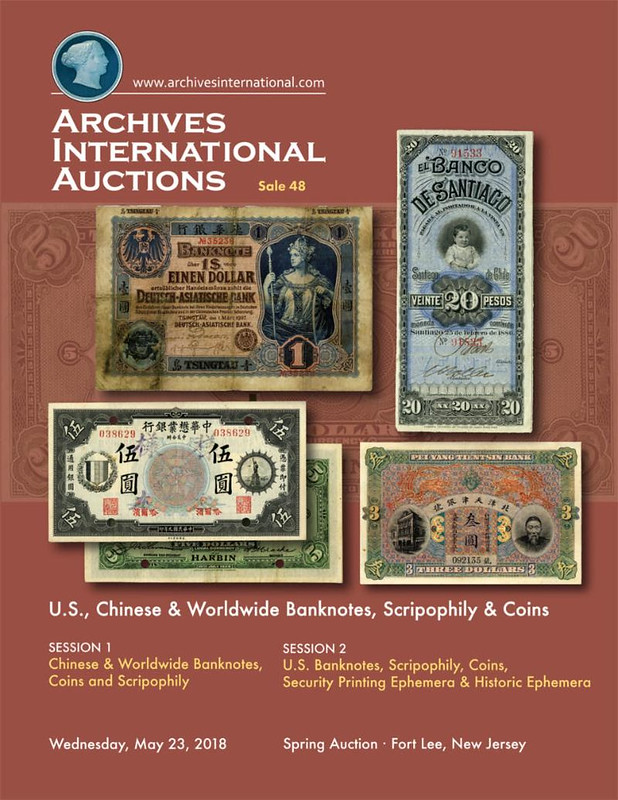
SUBSCRIBER PROFILE: CHRISTOPHER MCDOWELL
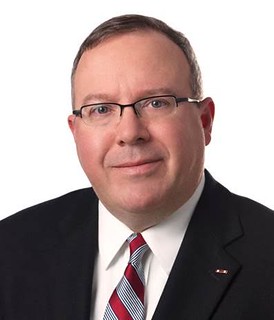 I became interested in coins as a boy looking at my father's Lincoln cent collection. As a paperboy, my dad collected pennies and put them in a book and I would look at the book and the holes in it. A few years
ago my dad gave me the book and I filled in all the holes with similar low-grade small cents and put my son's name on it to give to him one day.
I became interested in coins as a boy looking at my father's Lincoln cent collection. As a paperboy, my dad collected pennies and put them in a book and I would look at the book and the holes in it. A few years
ago my dad gave me the book and I filled in all the holes with similar low-grade small cents and put my son's name on it to give to him one day.
At Marshall University I majored in history and political science. I always wanted to obtain a Ph.D. in history, but went to law school instead as that choice provided the promise of a more lucrative future. When I got back to the United States after serving in the Army mostly overseas, I settled in Cincinnati because that is where my wife is from. I got into coin collecting coins once more because I was buying gold coins as an investment – that was when gold was under $350 an oz.
I purchased the gold coins at a coin store here in Cincinnati operated by Brad Karoleff and his partners. Brad is a true numismatist and proved to be a great early mentor. My interest turned to American Colonial Coinage for several reasons: first, I figured I could never gain an edge over coin dealers when it came to U.S. Mint products and if I was ever going to find bargains, I needed to find a niche in which I could know more than the man across the table; second, I soon realized that it presented a wonderful opportunity to research and write about American history – perhaps even more so than had I pursued that Ph.D. in 1994; finally, I wanted to collect something that I could work on for the rest of my life and not complete and not know all there was to know. The fact of the matter is that I can put together a collection of Roosevelt dimes in a day with enough money just sitting at my computer and learn all there is to know in a few hours.
I primarily collect Connecticut coppers and although I have over 300 different varieties, I will never have them all and I will never know all that there is to know about the mint or people who made the coins. These mysteries keep me going. Early American history has always been my favorite and bringing the stories of the people who created our great government to life is a passion. I would be remiss if I did not mention the great people I have met in the Colonial Coin community over the years. I genuinely enjoy everyone's company and many people have helped me in my research and collecting over the years.
A few years ago, I was provided the opportunity to become the editor of The Colonial Newsletter. As editor, I am now able to assist others in uncovering the mysteries and correcting the record of our numismatic past. During my short period as editor, the most significant contribution we have made at CNL has been the transcription and publication of the Connecticut Mint ledger books. These books help answer many of the questions we have had concerning the Connecticut Mint for over 150 years and will serve as a primary source of information to researchers for generations.
Out of my many articles, my favorite is titled “Slavery and Child Labor at the Connecticut Mint,” CNL, April 2017. In that article, I was able to show how a slave named Aaron worked at the Connecticut Mint stamping Fugio cents and compare his wages (when he worked extra hours, the mint paid him directly) to the rates paid a freedman, children, apprentices, and skilled laborers. I feel this is an article that transcends numismatics and provides insight into the lives of regular everyday workers at the mint. So often history is focused on great leaders and the stories of regular people are overlooked. It has brought me great joy to unearth the stories of these men and publish them in the pages of CNL.
REFLECTIONS ON A COLLECTOR: CHARLES J. RICARD
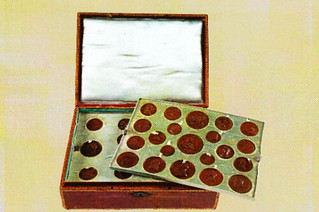 NBS past President Marc Ricard published an article about his late father Charles Ricard titled "Reflections on a Collector" in the Spring/Summer 2018 issue of The Intelligent Collector, a Heritage
house publication. With permission, here it is in its entirety. Thank you! -Editor
NBS past President Marc Ricard published an article about his late father Charles Ricard titled "Reflections on a Collector" in the Spring/Summer 2018 issue of The Intelligent Collector, a Heritage
house publication. With permission, here it is in its entirety. Thank you! -EditorCharlie Ricard's collecting career started at age 8, when, after nearly severing his fingertip in a car door, his uncle gave him a 1922 silver dollar to ease the pain. Little did he know that this simple act would lead to nearly seven decades of collecting, service and scholarship in numismatics.
Charles J. Ricard was born in Rochester, N.Y., in 1930 into a family with a numismatic heritage. The great-grandson of John C. Lighthouse, a famed collector at the turn of the century, Charlie followed in his ancestor's footsteps by joining the Rochester Numismatic Association at age 17, and the American Numismatic Association at 23.
After serving in the U.S. Army during the Korean War, he returned to Rochester and began studying numismatics under the mentorship of legendary coin collectors George Bauer and John Pittman. A potentially lucrative career as a coin dealer was the obvious next step, but Charlie knew that the thrill of building a collection was far more important to him than the “money side” of the business.
Using his GI Bill, he received his Bachelor of Science degree in accounting from the University of Rochester, becoming the first in his family to earn a college degree. This launched a nearly 50-year career as a bank auditor, where he helped bring the computer age into the world of banking. A move to Chicago in 1962 helped his business and collecting interests in a much larger forum. In Chicago, one of the major coin-collecting cities of the time, his connections paved the way to his leadership in local and national coin groups.
Also around this time, after researching his French ancestry, Charlie decided to learn everything he could about Napoléon Bonaparte and his legacy in numismatics. He set out to build the finest collection of Napoleonic medals that he could afford, and also share his knowledge with the collecting public. Charlie was fascinated with the beauty of the engravings, and would later find a family connection to the Duvivier family of French engravers. This connection drove him deeper into medal collecting, later expanding his collection to the bronze and porcelain works of art that depicted Napoleon and his family.
The author of numerous numismatic articles, he was a speaker at many local and national coin club events on a variety of subjects that he knew well. He was known for his generosity, taking time to answer questions from other collectors, as seen in his large archive of correspondence. And through these letters, he offers a glimpse into the real joy he had in sharing his love for the hobby with all collectors, young and old, famous and not so famous. It really didn’t matter to Charlie who you were. It only mattered that you shared a love of numismatics.
He was able to reach the heights of numismatics through his numerous awards and offices held. But he always remained a collector who tried to collect various pieces in their finest conditions, and learn as much about each piece that he could. He was a great husband, father and friend to many. But most importantly, he was a good man.
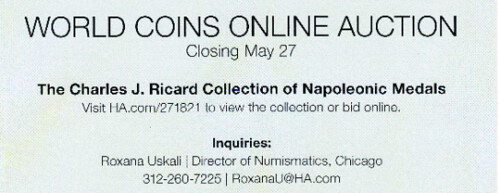
To read the complete article, see page 79:
THE INTELLIGENT COLLECTOR SPRING/SUMMER 2018 (http://intelligentcollector.com/mag/pdf-versions/2018-spring-summer-issue.pdf)
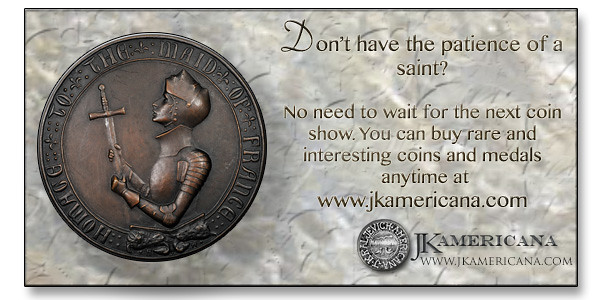
AUDIO: COINWEEK PODCAST #97 WITH JOHN KRALJEVICH
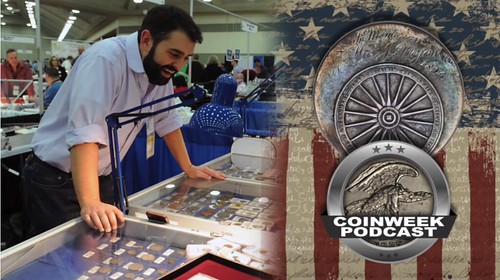
To listen to the podcast, see:
CoinWeek Podcast #97: Numismatic Americana Through the Eyes of John Kraljevich (https://www.youtube.com/watch?v=r_7hmLWkcKo)
VIDEO: 1964 MORGAN DOLLAR AD
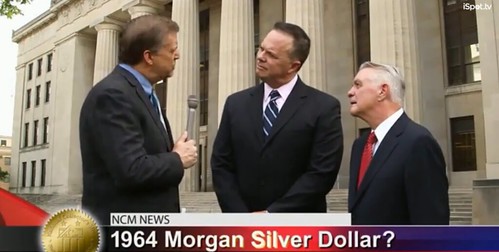
So says the narrator of this video add for a non-circulating Cook Islands silver coin mimicking the phantom 1964 U.S. Morgan Dollar.
As E-Sylum readers are aware, the obverse and reverse models for a 1964 Morgan dollar, plus hubs and master dies for the coin were discovered at the Philadelphia Mint in July 2015 by John Dannreuther and Dennis Tucker, in a group that also included Q. David Bowers and David Sundman. Obverse and reverse models for the 1964 Peace dollar were also found.
There is no connection whatsoever between the U.S. Mint, the actual hubs and dies, and these silver-plated souvenirs. But it's a fun historical re-enactment, I suppose. -Editor
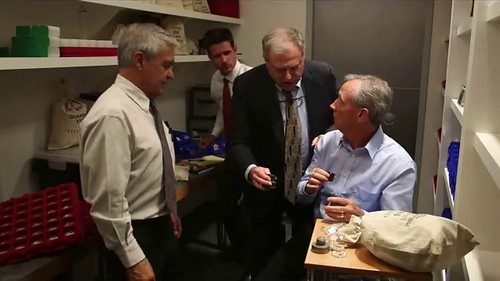

The coin that didn’t exist lives as a Non-Circulating Cook Islands’ Legal Tender Morgan Dollar clad in 71 mgs of .999 Pure Silver!
Dennis Tucker adds:
I like how they portray us pawing through a broom closet cluttered with piles of “coin stuff”!
Regarding the luxuriously silver-plated coin offered for sale in the ad, I shall withhold judgment.

Dennis Tucker, John Dannreuther, David Sundman, and Q. David Bowers
To watch the complete video, see:
National Collector's Mint TV Commercial, '1964 Morgan Silver Dollar: Vault'
(https://www.ispot.tv/ad/w2k3/national-collectors-mint-1964-morgan-silver-dollar-vault)
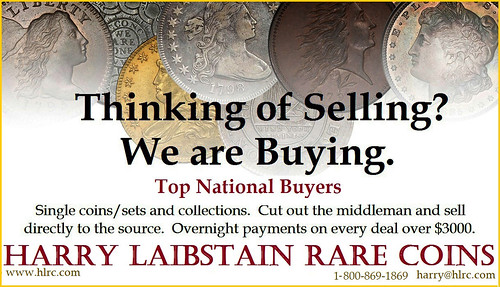
DECEPTIVELY ALTERED 1792 WASHINGTON CENT

Holed coin as seen in 2013
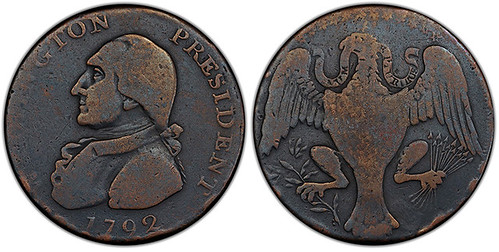
The same coin with hole plugged today
PCGS graders have identified a rare Colonial sporting a radically new appearance. The piece is an elusive 1792 Washington Eagle Cent – 13 star reverse, lettered edge; (Baker 21) from the Ted Craige collection, sold by Stacks Bowers on two occasions in 2013 (the Americana Sale 1/13 where it brought $3,055 and the ANA Sale 8/13 where it realized $9,988). The coin traces its pedigree back to Mayflower's Stern's Sale in December 1966. It was a pleasing light brown specimen with Fine sharpness, but was unfortunately holed at 12 o’clock on the obverse. There had also been a crude attempt to re-engrave the stripes on the shield on the reverse. Only about half a dozen examples are presently known, with at least half of these damaged in some way.
Earlier this year, there was considerable excitement at PCGS when we received what appeared to be a new, previously unknown example of this significant Colonial rarity. While the planchet was rather dark, the coin appeared to be undamaged and certainly worthy of a grade. It was only after some serious detective work that things began to look a bit strange. Some telltale marks began to match up, and despite looking superficially nothing like the holed piece, PCGS was able to conclude that the recently received coin was, indeed, none other than the Ted Craige specimen.
The quality of the alteration was nothing short of phenomenal. Not only had the surfaces been darkened to a very natural-appearing (though not particularly attractive) color, but also the re-engraving on the shield was gone and the hole had disappeared without a trace. Missing detail from where the hole had once been was flawlessly reconstructed. Even the stars at the top of the reverse seemed to once again be visible. PCGS founder David Hall noted it was easily "one of the most deceptive and clever alterations I’ve ever seen. The quality of the work was so good, it's scary! Had this one somehow slipped by, it could have easily brought $30,000 or more."
While PCGS is justifiably pleased with the sleuthing effort from the grading room, this coin serves as a powerful reminder that one cannot ever let down their guard and that some truly talented "doctors" are out there and capable of some very deceptive work. Obviously, expert authentication of rarities is a must for all serious coin buyers.
To read the complete article, see:
Incredibly Deceptive Alteration on Rare Colonial Caught by PCGS Graders
(https://www.pcgs.com/news/incredibly-deceptive-alteration-on-rare-colonial-caught-by-PCGS-graders)
Do coin doctors deserve scorn like counterfeiters?
In the Editorial this week, we explore whether coin doctors deserve the same kind of scorn as the counterfeiters of coins. As I write, “Coin doctors alter coins in an effort to improve their appearance and to mask problems; and while people can disagree on whether that is appropriate, it becomes fraud when a coin doctor attempts to sell a coin or have it slabbed by a third-party grading service without informing potential customers that it has been altered.”
To read the complete articles (subscription required for some articles), see:
Do coin doctors deserve scorn like coin counterfeiters?: Inside Coin World
(https://www.coinworld.com/news/us-coins/2018/05/do-coin-doctors-deserve-scorn-inside-coin-world.html)
PCGS warns of rare 1792 Washington ‘cent’ altered by coin doctor
(https://www.coinworld.com/news/us-coins/2018/05/coin-doctor-alters-rare-1792-washington-copper.html)
1802 HALF DIME QUESTIONED

I recently became aware of a sale by Silver City Auctions, March 21, 2018, lot 147. The coin was described as an 1802 half dime in uncertified XF and sold for $2900. There are probably many diagnostics but I noticed the position of the first star near the hair curl. This is a very expensive fake.
Did this slip by the numismatic community unnoticed?
For more information on the John Reich Collectors Society, see:
https://www.jrcs.org/
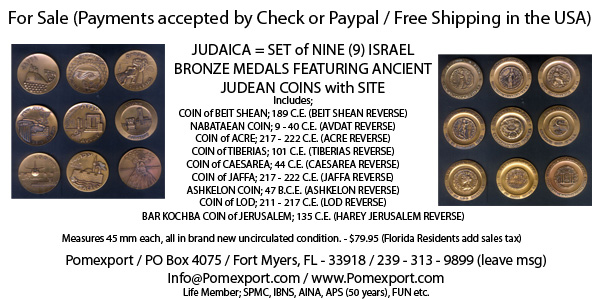
LAS VEGAS MAY 2018 COIN SHOW EVENTS
 Over 55 years ago, the first Vegas coin show opened as a gala event featuring show girls prancing with giant golden coins at the now defunct Sahara Hotel. Who would think this glitzy city was settled by
missionaries and the faithful looking for sanctuary from religious persecution?
Over 55 years ago, the first Vegas coin show opened as a gala event featuring show girls prancing with giant golden coins at the now defunct Sahara Hotel. Who would think this glitzy city was settled by
missionaries and the faithful looking for sanctuary from religious persecution?
In that Las Vegas Springs pioneer spirit, a rare complete certified set of Mormon Gold will be on exhibit. The six-coin set is valued at $1,700,000 and contains two of the finest known examples of this elusive pioneer gold. Only five completed sets are available to collectors and only 14 sets can be possibly assembled. This storied territorial accumulation has not been shown in over four years and is was collected and is owned by Robert Campbell of Salt Lake City, UT.
The Nevada Civil War History Association will build and re-enact the historic Mormon Fort and later mission, along with period dress and shoemaking. There will also be a large Carson City coinage and memorabilia exhibit sponsored by LVNS.
In our signature Saturday Seminars, learn about Mormon territorial gold and silver dollars with industry experts and renowned authors. Complimentary seating is limited
The popular Silver Dollar seminar is given by John Highfill and Michael Faraone. Highfill authored the Comprehensive US Silver Dollar Encyclopedia, founded the National Silver Dollar Roundtable and has been a silver dollar specialist for over 40 years. Faraone is an experienced rare coin authenticator, varieties specialist and a professional coin grader for over 23 years. Seminar begins at 12:00 noon.
 A Mormon Gold seminar is taught by Robert Campbell, in conjunction with the rare Mormon Gold exhibit. Campbell served as Past President, American Numismatic Association and is considered the largest active private
collector of Mormon coins, currency, medals, and tokens. Bob is a professional numismatist who owns and operates All About Coins Inc., in Salt Lake City for over 38 years. Seminar begins at 2:00 pm.
A Mormon Gold seminar is taught by Robert Campbell, in conjunction with the rare Mormon Gold exhibit. Campbell served as Past President, American Numismatic Association and is considered the largest active private
collector of Mormon coins, currency, medals, and tokens. Bob is a professional numismatist who owns and operates All About Coins Inc., in Salt Lake City for over 38 years. Seminar begins at 2:00 pm.
Learn from industry experts, John Highfill, Michael Faraone and Robert Campbell at the CK Shows sponsored Saturday seminars. Attendees will find education on Mormon territorial gold and silver dollars. Seating is limited on all seminars and is complimentary with admission.
For more information on the Las Vegas Numismatic Society, see:
http://lasvegascoinclub.com/
SEDWICK MAY 2018 AUCTION HIGHLIGHTS
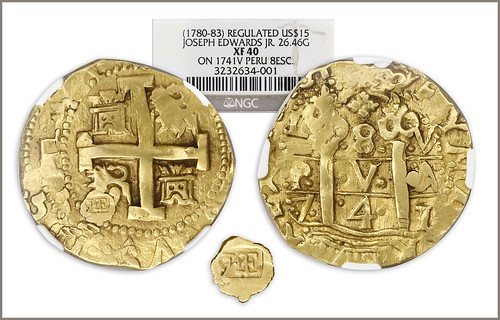
In the early years of the United States of America, a lack of gold coinage forced citizens to utilize an unusual but practical source. Known as regulated gold, these were foreign gold coins adjusted by respected goldsmiths to weights compatible with US dollars. One such piece, an NGC-graded XF 40 Lima, Peru, cob 8 escudos dated 1741 struck during the reign of Philip V of Spain and regulated by Boston goldsmith Joseph Edwards, Jr. (1737-1783) to $15 in circulating value, will cross the auction block in Daniel Frank Sedwick's Treasure Auction 23. The sale will be held online at auction.sedwickcoins.com on May 15-16, 2018. The auction firm's estimate for this coin is $100,000 and up.
“This is a very important piece for both the Spanish colonial coin collector as well as the US collector,” said company president Daniel Sedwick. “Never before have we offered such a significant gold coin; the dual-nation history it represents goes far beyond a simple countermark.”
 Also appearing in Sedwick's auction is a group of ingots recovered from seven different shipwrecks. The top ingot lots are three large silver bars recovered from the Atocha, sunk in 1622 in the Gulf of Mexico.
The finest one is a Class Factor 1.0-graded bar (the highest grade attainable for bars from the wreck) weighing in at 88 troy pounds, 3.84 troy ounces and dated 1621. It has an estimate of $30,000 and up. The other two large
bars, with Class Factors 0.7 and 0.9, are estimated at $20,000 to $30,000 each. Another Atocha ingot of note in this auction is a rare cylindrical “piña” weighing 4,312 grams, estimated at $15,000 and up.
Also appearing in Sedwick's auction is a group of ingots recovered from seven different shipwrecks. The top ingot lots are three large silver bars recovered from the Atocha, sunk in 1622 in the Gulf of Mexico.
The finest one is a Class Factor 1.0-graded bar (the highest grade attainable for bars from the wreck) weighing in at 88 troy pounds, 3.84 troy ounces and dated 1621. It has an estimate of $30,000 and up. The other two large
bars, with Class Factors 0.7 and 0.9, are estimated at $20,000 to $30,000 each. Another Atocha ingot of note in this auction is a rare cylindrical “piña” weighing 4,312 grams, estimated at $15,000 and up.
- A Lima, Peru, gold cob 8 escudos dated 1712 recovered from the 1715 Fleet and graded by NGC as MS 62, estimated at $12,500.
- Half of a gold “finger” bar weighing 439 grams recovered from the “Golden Fleece wreck,” sunk ca. 1550 in the northern Caribbean, estimated at $17,500 and up.
- A Costa Rica 8 reales 1846JB counterstamp on a Guatemala cob 8 reales dated 1739, estimated at $7,000 to $10,000.
- An 1856-S Coronet Head Liberty $20 graded by NGC as UNC Details / sea salvaged from the “Fort Capron treasure,” estimated at $3,000 to $4,500.
- A Puerto Rico 20 pesos specimen bank note circa 1889 graded by PMG as Gem UNC 65 EPQ (the finest and only known example in the PMG census), estimated at $1,500 and up.
- Selections from the Richard Stuart collection mainly focusing on Honduras and Nicaragua provisional issues.
- The James Bevill collection of Mexican coins and paper money, including several plated in his Texas history book The Paper Republic.
- The Ricardo Muñiz collection of Mexico City, Mexico, pillar 1 reales.
Bidders can register for the auction at www.auction.sedwickcoins.com. The auction catalog will is available at www.sedwickcoins.com. For more details, please contact Daniel Frank Sedwick, LLC at office@sedwickcoins.com.

ARCHIVES INTERNATIONAL SALE 48
U.S., CHINESE AND WORLDWIDE BANKNOTES, SCRIPOPHILY AND COINS WILL BE OFFERED IN 2 SESSIONS AT PUBLIC AUCTION ON WEDNESDAY, MAY 23rd , 2018
The auction will be held by Archives International Auctions, at their offices in Fort Lee, N.J.
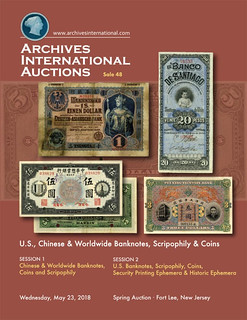 The May 23rd auction will feature an extensive collection of over 990 lots of U.S., Chinese and worldwide banknote rarities; a desirable collection of U.S. Obsolete Banknotes and Small Type Nevada National
Banknotes as well as hundreds of additional banknotes, stocks, bonds, and historic autographs.
The May 23rd auction will feature an extensive collection of over 990 lots of U.S., Chinese and worldwide banknote rarities; a desirable collection of U.S. Obsolete Banknotes and Small Type Nevada National
Banknotes as well as hundreds of additional banknotes, stocks, bonds, and historic autographs.
Included in the sale are consignments from numerous estates and longtime collections with many items having never been previously offered at auction. The sale is broken into two sessions, the first includes U.S., Chinese and Worldwide Banknotes, Chinese Scripophily, and Coins; the second session begins with Colonial and Obsolete banknotes, Large and small type, Confederate, and Security Printing Ephemera and ends with U.S. and Worldwide Scripophily.
The auction will include over 540 lots of Chinese and Worldwide banknotes with a significant number of group lots that include dozens if not hundreds of desirable notes. We also have an exciting collection of Replacement notes from a serious collector covering literally the entire globe with many interesting and rare issues. Also included in the auction is a large Queen Elizabeth II collection put together by a serious New York collector over the last 30 years. Included are many desirable notes that will enhance any British Colony collection and includes many elusive issues.

Chinese-American Bank of Commerce, 1920 "Harbin" Branch Issue Rarity
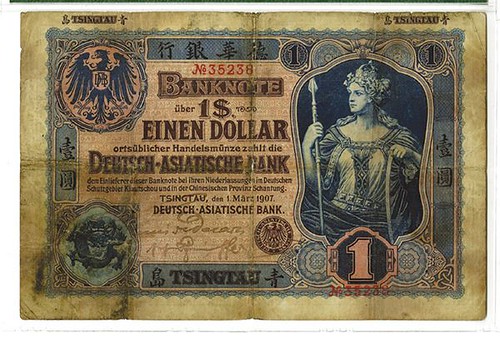
Deutsch-Asiatische Bank, 1907, "Tsingtau" Branch Issue Rarity
We are offering over 100 lots of Chinese Banknotes and Scripophily highlighted by a discovery 1920, Chinese-American Bank of Commerce, $5 "Harbin" Branch Issue Rarity that is very possibly unique and a Deutsch-Asiatische Bank, 1907, "Tsingtau, Kiau Chau" issued $1 Branch Issue Rarity. Numerous desirable and rare notes fill out the Chinese section of the auction. Chile is highlighted by a Banco De Santiago, 1886 Issued 20 Pesos note that rarely is seen at auction and is offered by us for the first time. An extremely attractive and high-grade Kuwait Currency Board, 1960-1961, Complete First Issue Set of 5 Banknotes is offered and rarely seen is this high of condition; as well as Mexico, which is highlighted by a 500 Pesos, Banco De San Luis Potosi, ND (1897-1913), Face and Back Proofs, both PMG grading Gem Unc 66 EPQ.
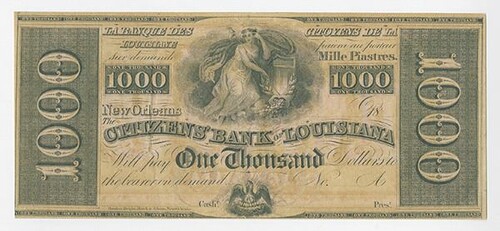
Citizens' Bank of Louisiana $1000 note

State Bank, Lecompton, K.T., 1856 Issued Obsolete Banknote
The second session includes U.S. Banknotes, Scripophily, Historic Ephemera and Security Printing Ephemera. Highlights include an attractive collection of over 50 obsolete banknotes including a desirable selection of Louisiana obsoletes featuring a $1000, Citizens Bank of Louisiana; a Kansas Territory, State Bank, Lecompton, K.T., 1856, $2, KS-55 G4a, Whitfield 334 issued obsolete; and dozens of attractive notes. U.S. Type Notes are highlighted by a National Banknote Collection including a Mechanics National Bank of Philadelphia, 1875, $1, Ch#610; and a small collection of 5 different 1929 Nevada Nationals including notes from Ely, Eureka, Reno and Winnemucca, Nevada; as well as dozens of additional rare and attractive notes.
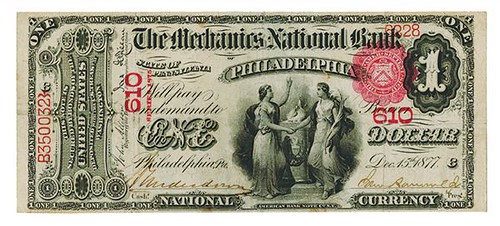
Mechanics NB Philadelphia $1 National Currency
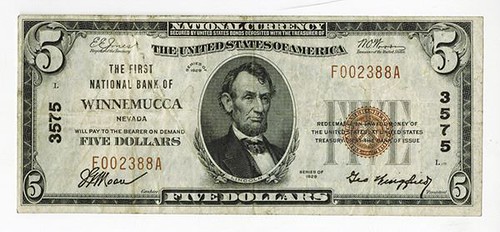
First NB of Winnemucca $5 National Bank Note
Scripophily is represented by over 300 lots including banking, mining, navigation, foreign and U.S. issued and specimen stocks and bonds that includes many desirable and rare issues rarely offered at auction.
The auction will feature hundreds of additional rare and desirable banknotes, coins, and scripophily in every price range, for the beginner to the advanced collector. Previews will be held at Archives International Auctions offices Monday, May 21 st ; Tuesday, May 22 nd and by Appointment. For an appointment call 201-944- 4806 or email info@archivesinternational.com.
The online catalog for the May 23 rd sale is on Archives International Auctions’ website and can be viewed via the Archives International live bidding platform. It can also be viewed as a virtual catalog or downloadable .pdf on their website. To pre-register for live internet bidding, log on to the Archives International Auctions website, at www.ArchivesInternational.com.
We are now working on our Summer and Fall 2018 auctions and are seeking quality consignments for future auctions or outright purchase including U.S. and worldwide banknotes, coins, stocks, bonds, stamps, postal history, historic ephemera, and autographs. To sell or consign one piece or an entire collection, please call AIA at (201) 944-4800; or e-mail them at info@archivesinternational.com.
We are also offering hundreds of interesting and rare banknotes, Bonds and Shares and historic ephemera in 7-day sales on eBay under our eBay ID: ArchivesOnline.
You may also write to Archives International Auctions, at 1580 Lemoine Ave., Suite #7, Fort Lee, NJ 07024 U.S.A. To learn more about Archives International Auctions and the auctions planned for November 16th, log on to www.ArchivesInternational.com.
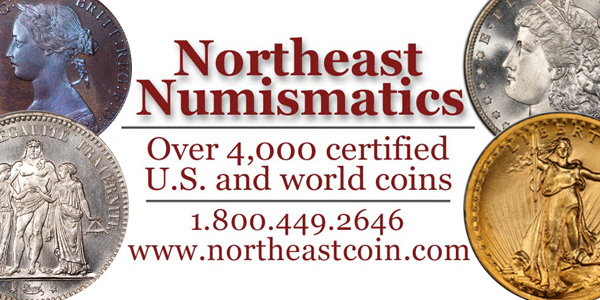
WAYNE'S NUMISMATIC DIARY: MAY 13, 2018
Tuesday night was the regular meeting night of my Northern Virginia numismatic social group Nummis Nova. Our host was Aaron Packard and our venue was Southside 815, a restaurant on South Washington street in Alexandria, VA.
On my journey there after work I said some hurtful things to my GPS system, which managed to lead me into an express lane with no escape that forced me to cross the Potomac and turn around on a back road at the National Harbor complex.
When I arrived around 6pm several folks were already there, including Eric Schena, Joe Esposito, Gene Brandenburg, Dave Schenkman, and Robert Hoppenstedt. Arriving shortly thereafter were Steve Bishop, Lenny Goldberg, Tom Kays and Aaron himself, who took a seat next to me.
Snowden's Coins of the Bible
I've forgotten who I first spoke to about this little book in my numismatic library, but i brought it in to show.
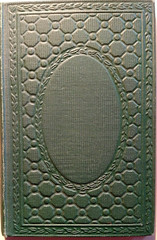
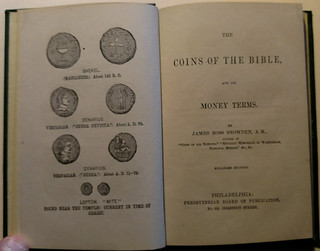
This tiny 1864 volume by U.S. Mint director James Ross Snowden is quite rare. Having spoken on the topic of coins of the Bible in Sunday school, he gathered his lectures into a book at the request of several members of the congregation. It was published by the Presbyterian Board of Publication.
1933 Double Eagles
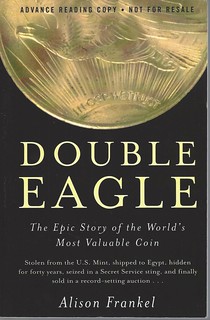

 With the 1933 Double Eagles being discussed at this weekend's PAN show, I decided to bring a couple books about the coins along with Len Augsburger's Treasure in the Cellar, abotu another valuable
gold find.
With the 1933 Double Eagles being discussed at this weekend's PAN show, I decided to bring a couple books about the coins along with Len Augsburger's Treasure in the Cellar, abotu another valuable
gold find.
Butte, Montana So-Called Dollars
I work with a woman from Butte, Montana and somehow we got to talking one day about the mines from that area and their tokens. She had seen an image of one she was curious about and shared it with me. I checked with some
friends and quickly learned it was actually a medal, part of the So-Called Dollar series documented by Hibler & Kappen.
As it happened Dave Schenkman had all of the varieties in his collection and at my request brought them to the meeting so I could see them. He kindly provided these photos.
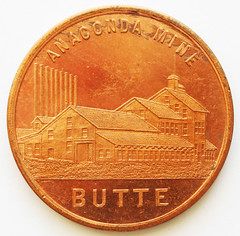

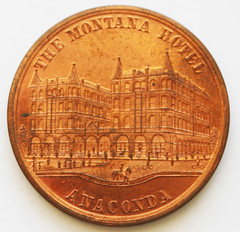
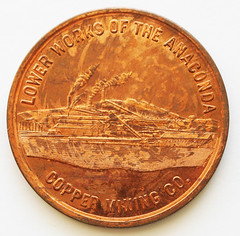
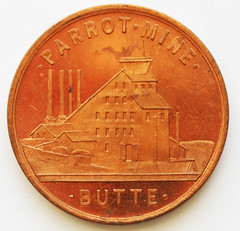
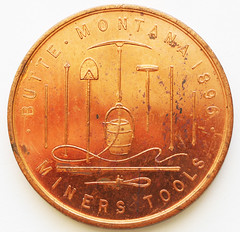
Separately I obtained an example of the Anaconda Mine piece (HK734) from Jeff Shevlin so I can give it to her.
Admiral Dewey Relic Medal
Dave also brought along an interesting relic medal, and he shared these images and comments. Thanks! A relic medal is one made from material recovered from the thing being commemorated - in this case, bronze captured in the
Spanish American War.
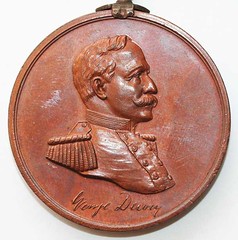


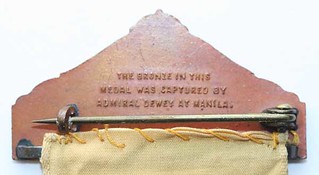

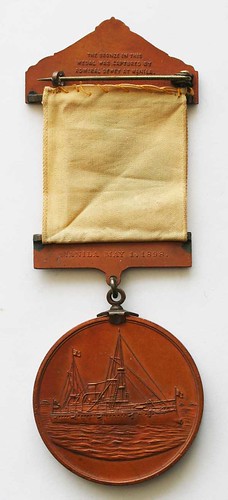
Dave writes:
While not rare, it is one of the more interesting pieces emanating from the Spanish American War. Overall length is approximately 120mm, while the medal itself is 45mm. The medal and bars are bronze. The wording on the reverse of the top bar is THE BRONZE IN THIS MEDAL WAS CAPTURED BY ADMIRAL DEWEY AT MANILA. An article about these medals, written by William S. Dewey (who was related to the famous Admiral) was published in the TAMS Journal many years ago.
Dinner in Camelot
Joe Esposito missed last month's dinner while he was travelling the country promoting his new book, Dinner in Camelot. Gene Brandenburg and I celebrated his return by wearing our Dinner-in-Camelot campaign-style
buttons. I'd picked up mine at Joe's book signing at the Politics and Prose bookstore.
This week I noticed this great item on Joe's Facebook page:
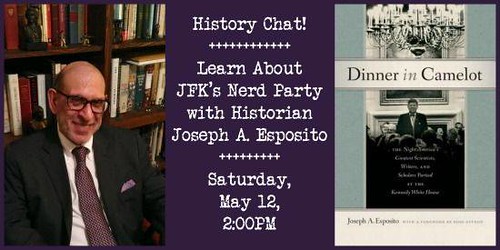
Several people have rightly suggested that his book about the night Nobel laureates and other intellectuals gathered at the White House in 1963 would make a fine basis for a film. I think that's what caused me to mention the upcoming film with Paul Rudd based on the book about Moe Berg called The Catcher Was a Spy.
Joe writes:
The other night we were talking about The Catcher Who Was a Spy. Here's the trailer.
The book on which it was based, The Catcher Was a Spy: The Mysterious Life of Moe Berg by Nicholas Dawidoff was very successful and an absorbing book.
To watch the movie trailer, see:
The Catcher Was a Spy Official Trailer #1 (2018) Paul Rudd War Movie HD (https://www.youtube.com/watch?v=Ffmzqctbkbo)
To read the earlier E-Sylum articles, see:
MOE BERG'S PRESIDENTIAL MEDAL OF FREEDOM (http://www.coinbooks.org/esylum_v19n35a33.html)
NOTES FROM E-SYLUM READERS: SEPTEMBER 11, 2016 : Moe Berg Jewish-American Hall of Fame Medal (http://www.coinbooks.org/esylum_v19n37a12.html)
Before I knew it it was time to head home, but I'm already looking forward to next month.

THE COUNTERSTAMPS OF DR. E. OSGOOD
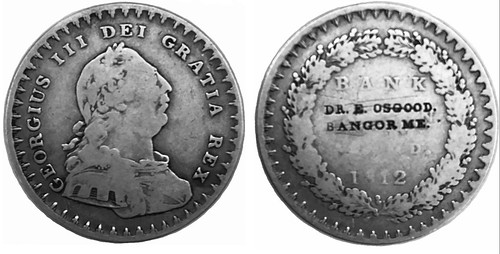
Countermarked coins can provide unique insights into eras long ago, particularly the mid- to-late 1800's when this advertising practice was most prevalent. These pieces do not need to be common, even rare pieces can provide a clear window to the past. For instance, two very different coins are known with the countermark of a Dr. E. Osgood (Brunk O-134). The countermark DR. E. OSGOOD. / BANGOR ME. is on the reverse of a British George III silver 18 pence bank token of 1812; it was sold in Presidential Coin and Antique Co. Auction 82 (as lot 35) in June 2012.

There is also a single 1854 United States seated dime (arrows at date) known with just the DR. E. OSGOOD. countermark on the obverse. This latter piece was sold in an eBay auction in July 2017. The British 18 pence token is a highly unusual host for an advertising countermark. In the later part of the reign of George III the price of silver was high, and there was a shortage of silver coins available for circulation. The Bank of England sought to alleviate this problem by issuing tokens of both three shillings and 18 pence in 1811, and for subsequent years until 1816. The initial design of the 18 pence token featured a draped bust of George III in Roman armor on the obverse, but this was changed in 1812 to a design featuring a laureate head and truncated neck. Some changes were made to the reverse also. The token countermarked by Dr. Osgood is this second type.
Thanks to Editor Eric Schena for forwarding the files. -Editor
For more information on the Token and Medal Society, see:
http://www.tokenandmedal.org/
To read TAMS Journals from 1961 through 2015 on the Newman Numismatic Portal, see:
https://nnp.wustl.edu/library/publisherdetail/515304
MOSCOW ARCHAEOLOGISTS FIND PICKPOCKET COIN
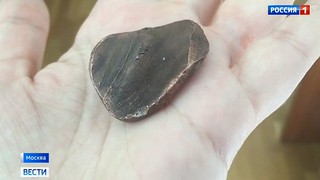 Archaeologists digging in an historic part of central Moscow have found all sorts of objects in recent months, but perhaps nothing as interesting as the oldest example of a pickpocket's coin to come to light in
the city.
Archaeologists digging in an historic part of central Moscow have found all sorts of objects in recent months, but perhaps nothing as interesting as the oldest example of a pickpocket's coin to come to light in
the city.
The two-kopeck coin dates back to the mid-18th century, but what makes it different is the way one edge was hammered flat and then filed down to a sharp blade. This allowed artful pickpockets to slice open bags and coats to get at the moneybags of unsuspecting passers-by, Russia's Vesti television news programme reports.
"Thieves' coins", as they were known in Russia, were an essential tool of the resourceful footpad. This one came to light during building work on the Soimonov Passage in the city centre, and archaeologists say the type of two-kopeck piece was only minted in 1757-1761, towards the end of the reign of Empress Elizabeth, a daughter of Peter the Great.
Alexei Yemelyanov, the head of the city's Cultural Heritage Department, told the Mayor's official website that the coin could also be used as a shiv to slash a victim's hand or face if they realised they were being robbed.
The work on the Soimonov Passage is part of the "My Street" project to restore the city centre. It has been under way for several years, and has turned up a variety of finds, some of them decidedly picaresque.
These range from a 17th-Century stamp that forgers used to make counterfeit coins - dug up on Tverskaya Street near Red Square - to the remains of long-lost thieves' dens, including the notorious 18th-century Skachek inn under Manege Square.
To read the complete article, see:
Moscow archaeologists find oldest pickpocket coin (http://www.bbc.com/news/blogs-news-from-elsewhere-44088275)
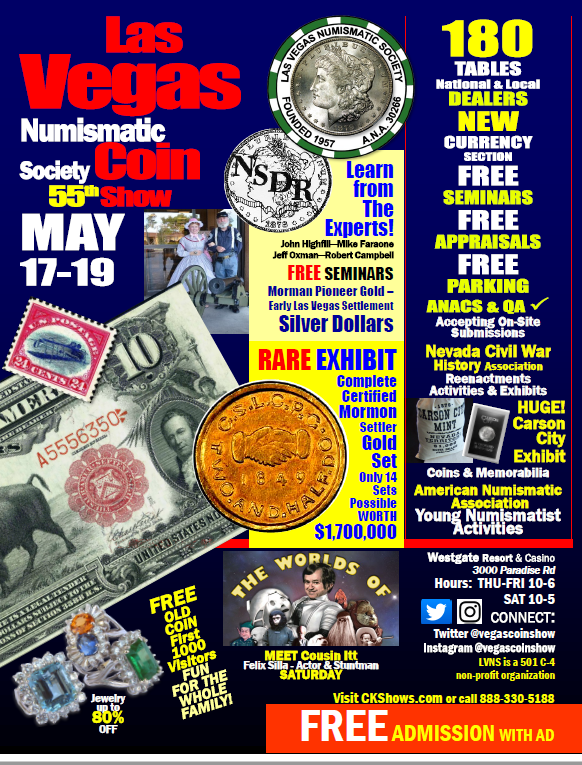
IRVING BERLIN CONGRESSIONAL MEDAL IMAGE FOUND
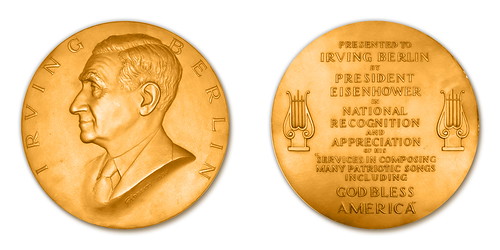
Following years of searching, Mel Wacks has finally obtained pictures of the Congressional Gold Medal presented by President Eisenhower to Irving Berlin on February 18, 1955. Wacks knew that Irving Berlin was awarded a Congressional Gold Medal by the bill P.L. 83-536, 68 Stat. A120, approved on July 16, 1954 and signed by President Dwight Eisenhower at the White House a few days later, witnessed by Irving Berlin and his wife. There are pictures of Eisenhower signing the bill and pictures of Eisenhower presenting the gold medal to Irving Berlin—but there were no pictures of the medal. Not even Google could unearth a picture.
So, Mel Wacks wrote to the Department of the Treasury, and requested a photo of Irving Berlin's Congressional Gold Medal under the Freedom of Information Act. In a letter from the Department of the Treasury, dated January 30, 2018, Lateau Jones, Acting Disclosure Officer/Freedom of Information Act Public Liaison enclosed photos of the medal and the galvanos (signed “G[ILROY] ROBERTS 1954). Since the pictures were black and white, Wacks had a friend, Manu Sagarbarria, color them gold.
Irving Berlin's Congressional Gold medal (in full color) is featured for the first time on the front cover of The Shekel, the quarterly magazine published by the American Israel Numismatic Association (which Mel edits) and in an article about Irving Berlin, composer of “God Bless America,” that celebrates the theme of Jewish American Heritage Month (May)—Jewish contributions to American music. The medal's picture will also be added to Irving Berlin's biography on the Jewish-American Hall of Fame's website www.amuseum.org/jahf.
A copy of this issue of The Shekel, The Journal of Israel and Jewish History and Numismatics, along with the three other issues published in 2018, can be obtained by sending $25 dues (in USA) to AINA, P.O. Box 20255, Fountain Hills, AZ 85269. Further information about AINA can be found at www.theshekel.org.
ISRAELI NONPROFIT COINS TRUMP TRIBUTE
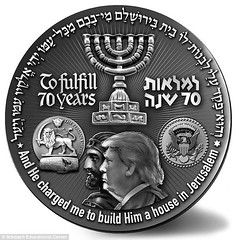
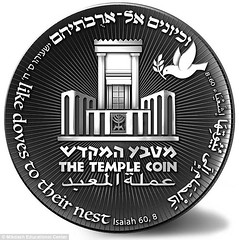
Donald Trump's face will feature on Israeli coin marking 70th anniversary of Israel independence, following decision to move US embassy to Jerusalem.
Donald Trump's face will feature on an Israeli coin marking the 70th anniversary of the country's independence.
It depicts the US President alongside the biblical King Cyrus, who allowed the Jews to return to Jerusalem 2,500 years ago.
The coin, which cannot be used as currency, is also a token of gratitude for Mr Trump's decision to move the US embassy from to Jerusalem, KOBI reported.
Nonprofit organisation The Mikdash Educational Center has made 1,000 of the half-shekel celebratory coins.
To read the complete article, see:
Donald Trump's face will feature on Israeli coin marking 70th
anniversary of Israel independence, following decision to move US embassy to Jerusalem
(http://www.dailymail.co.uk/news/article-5718129/Donald-Trumps-face-feature-Israeli-coin-marking-70th-anniversary-Israel-independence.html)

BULGARI'S COIN JEWELLERY
 Bulgari presents a unique combination of fine watchmaking, high jewellery and rare currency in the limited-edition Monete high jewellery pendant watch. Priced at just over HK$3 million, it includes a silver
tetradrachm featuring Alexander the Great, set in 18ct pink gold with rubies and 36.54ct of diamonds.
Bulgari presents a unique combination of fine watchmaking, high jewellery and rare currency in the limited-edition Monete high jewellery pendant watch. Priced at just over HK$3 million, it includes a silver
tetradrachm featuring Alexander the Great, set in 18ct pink gold with rubies and 36.54ct of diamonds.
The flip side reveals an ancient silver coin, but the front blends antiquity with the modernity of a skeletonised watch movement Calibre BVL 208.
Rare ancient Greek and Roman coins, each with a distinct patina, are one of the icons of the Rome-based jeweller, enabling Bulgari to resort to unusual combinations of materials.When unique materials are mixed, works of art emerge as more than just a piece of adornment.
As Pablo Picasso said: “We all know that art is not truth. Art is a lie that makes us realise truth, at least the truth that is given us to understand.”
To read the complete article, see:
Jewellery designers push boundaries by mixing precious gemstones with unconventional materials
(http://www.scmp.com/magazines/style/watches-jewellery/article/2145027/jewellery-designers-push-boundaries-mixing)
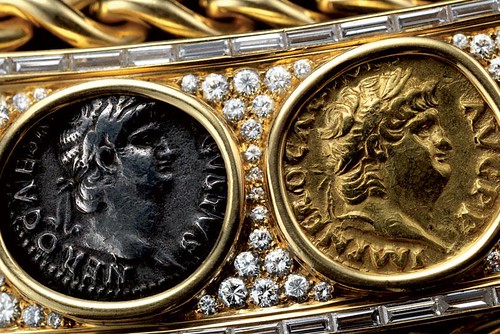
One of the most celebrated Bulgari icons ever, the pieces mounting antique coins have been introduced as a long-standing tradition in jewellery dating back to Ancient Rome. As an enthusiastic coin collector, Nicola
Bulgari encouraged the Bulgari Monete jewels to make their debut in the ‘60s. In all the pieces the coin's structure remains unaltered and the mounts follow the contours highlighting the play of contrasts, the common
denominator of these creations.
The premiere coin jewels made in 1966 were as elegant as they were modern, engraved with the name of the emperors, the dates they were in power and the type of coin. This educational element became a permanent part of the
coin collections.
To viit the company web site, see:
Bulgari Icons (https://www.bulgari.com/en-gb/bulgari-heritage-icons)
The look of most patriotic fine jewels is straightforward—American flag brooches set with rubies, diamonds and sapphires. Bulgari took a far more imaginative approach to its love of the United States.
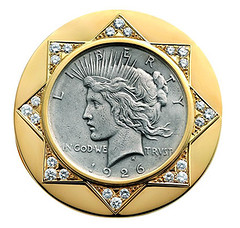 In 1972, a year after opening a New York boutique, the legendary Italian firm launched its first jewelry tribute to the USA. Stars and stripes from Old Glory were transformed on to hoop earrings, chain necklaces
and pendants for neck wires. Diamonds lit up red and blue enamel or coral and lapis on the jewels. The Star Spangled Banner Collection caused a sensation when Richard Avedon photographed Cher for Vogue wearing several pieces
with Eres bathing suits. The images showed how Bulgari was in sync with the laid back luxurious state of the nation.
In 1972, a year after opening a New York boutique, the legendary Italian firm launched its first jewelry tribute to the USA. Stars and stripes from Old Glory were transformed on to hoop earrings, chain necklaces
and pendants for neck wires. Diamonds lit up red and blue enamel or coral and lapis on the jewels. The Star Spangled Banner Collection caused a sensation when Richard Avedon photographed Cher for Vogue wearing several pieces
with Eres bathing suits. The images showed how Bulgari was in sync with the laid back luxurious state of the nation.
Bulgari's other designs made in homage to America grew out of Nicola Bulgari's interest in numismatics. One of founder Sotirio Bulgari's grandsons, Nicola had been a enthusiastic collector of ancient Roman and Greek coins from childhood. In 1966, when he was just twenty-five years old, he came up with the idea for the wildly popular Monete gold and coin jewelry. Five years later, Nicola moved to New York to run the new boutique and American coins became his passion. The same way he appreciated the chronicle of events that ancient coins revealed, he enjoyed the narrative of the New World in American coins and medals. Nicola told The New York Times reporter Bernadine Morris in 1976, “I’m a coin collector myself but I never knew there were such interesting American ones before we started this project. You can learn a lot of history this way.” Nicola personally selected each of the American coins used in the special Monete jewels made during the 1970s.
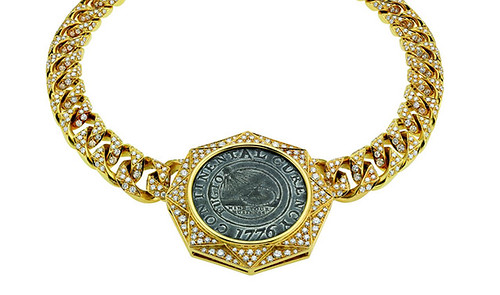
One fascinating coin set in a Bulgari necklace made to celebrate the 1976 American Bicentennial was a 1776 pewter Continental Dollar. Designed by Founding Father Benjamin Franklin, it was the first coin minted when the thirteen colonies incorporated. The imagery on the front of the Continental Dollar includes a sun, sundial and the Latin motto “Fugio.” Together the elements are believed to mean: mind your business, because time flees.
One Bulgari necklace created in the 1970s features a gold medal Hamilton fans are sure to love. It depicts General Lafayette in profile on the front. “The defender of American and French Liberty” is on the back. The medal was issued to commemorate Lafayette's return to America in 1824. Bulgari mounted the medal on a chain necklace within a setting of rubies, diamonds and sapphires. The Latin word for liberty is emblazoned along the bottom of the pendant. An eagle and fleur-de-lis accent the sides.


To read the complete article, see:
Italians Made the Best Patriotic Jewels
(https://theadventurine.com/culture/jewelry-history/italians-made-the-best-patriotic-american-jewels/)
To read the earlier E-Sylum article, see:
2018 ANS GALA DINNER (http://www.coinbooks.org/v21/esylum_v21n04a07.html)
THE BOOK BAZARRE
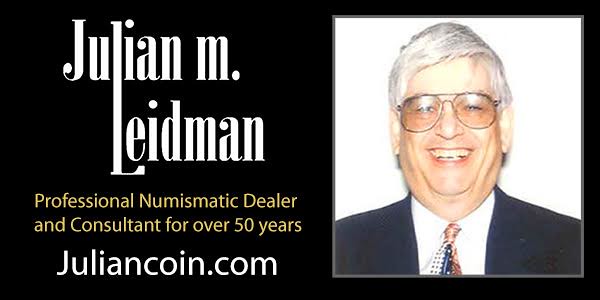
ROCK CARVING OF WORLD'S EARLIEST BANKNOTE
A rock carving of a "Jiaozi," which is believed to be the world's earliest paper currency, was discovered in southwest China's Chongqing Municipality, archaeologists said Friday.
Jiaozi was printed in the Northern Song Dynasty (960-1127) and is regarded by most experts as the world's first paper currency, according to Dazu cultural research center.
Deng Qibing, archaeologist with the center, said that the carving was found on a stone inscription at the Dazu Rock Carvings, a World Heritage site, in Chongqing. Beside the Jiaozi carving, more than 40 coins were loosely carved on the stone.
Carvings of ancient coins are often found at the site, but this is the first time for archaeologists to discover paper currency carvings.
To read the complete article, see:
Rock carving of world's earliest banknote discovered in China (http://www.xinhuanet.com/english/2018-05/11/c_137172448.htm)
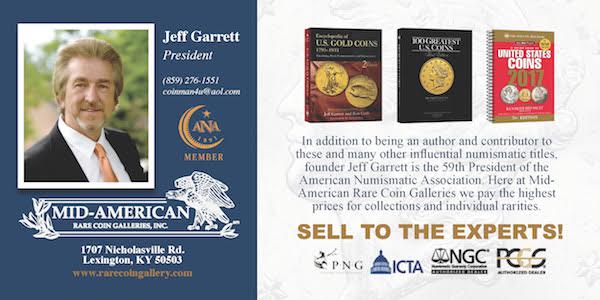
AUSTRALIA'S MYSTERIOUS BANKNOTE VAULT
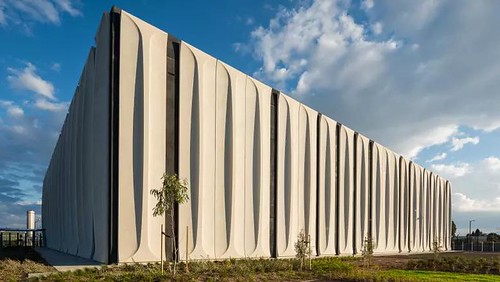
The cube looms on the horizon like a Bond villain's lair and boasts enough security to make even the most paranoid evil mastermind feel safe.
Three high-tensile fences surround the mysterious monolith amid rows of floodlights and a checkpoint manned by armed guards.
There are fingerprint scanners, heavy steel doors and endless cameras to prevent anyone from getting to the treasure held within.
There are no signs revealing what's inside but the imposing exterior suggests something very valuable. Perhaps national secrets, or a confidential lab experiment.
For once, the reality is just as exciting: the cube is brimming with billions of dollars in cold hard cash. This is the National Banknote Site, Australia's Fort Knox.

On a recent tour, The Age was given a close-up look at the extraordinary levels of security and the way cash is dispensed on the first steps of its journey into our wallets and purses.
The man taking us inside is Michael Andersen. As the RBA's head of note issue, he has overseen the first major overhaul of Australia's banknotes since polymer bills replaced paper cash in 1992.
The intention of the vault's design, he says, was to create as many safeguard layers as possible. Breaching one in a heist might be possible but getting through all of them would not.
"It's like an onion and no one knows them all," he says.
Once inside, we move through a series of steel doors, which are activated with a fingerprint scanner or passcode. Only one can be opened at any point and they close automatically with a heavy click.
"It's like Maxwell Smart," says Mr Andersen, "and if these doors closed on you, you’d really know about it."
To read the complete article, see:
Inside the mysterious vault that has locals scratching their heads
(https://www.theage.com.au/national/victoria/inside-the-mysterious-vault-that-has-locals-scratching-their-heads-20180503-p4zd6t.html)
